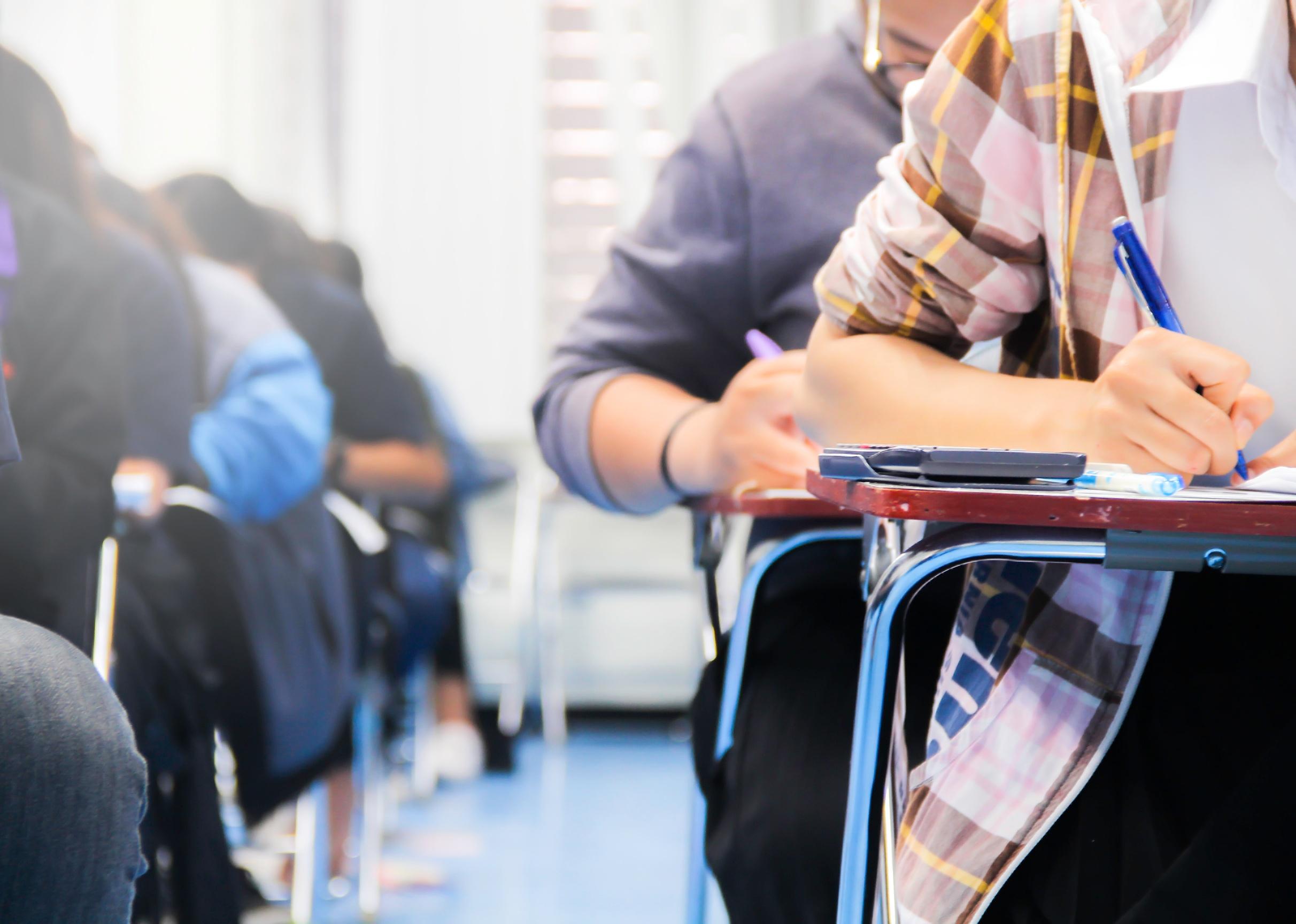
States spending the most and least per student on education
States spending the most and least per student on education
U.S. states and localities pay huge portions of their budgets toward educating their children, and it never seems to be enough. Research consistently finds funding is neither adequate nor equitable, and that students from low-income households, Black students, students with disabilities, and students who do not come from English-speaking homes bear the brunt of those inadequacies and inequities.
Funding for schools in America stretches dramatically from a low of just $7,628 per student in Utah to a high of more than $24,040 in New York. Some states use progressive taxation such as property taxes, in which taxpayers pay according to the value of their assets. Others turn to regressive levies like sales taxes that apply the same tax rate to rich and poor.
This year, school funding became all the more challenging when the coronavirus pandemic hit. Businesses closed, schools shut down, and consumer spending dried up, all pointing to severe shortfalls in tax revenues that normally would help keep schools going.
Many school districts saw their enrollment plummet, as students opted to stay home to avoid the possibility of infection and did not participate in remote learning. Many parents kept their young children out of kindergarten. Unfortunately, many districts' funding is predicated on their enrollment, so serious cuts ensued. Federal stimulus funds from the Coronavirus Aid, Relief, and Economic Security Act, known as the CARES Act, helped, but they were only temporary.
To look at school funding, Stacker evaluated the U.S. Census Bureau's most recent Public Elementary-Secondary Education Finance Data—released in April 2020—to determine which states put the most toward their primary and secondary education systems. The 50 states and Washington D.C. are ranked by total spending per pupil in the 2018 fiscal year. Each slide also includes spending breakdowns such as salaries and wage spending, pupil support spending, and general administrative spending to demonstrate exactly how public funds for education are used. Each spending amount is calculated per pupil.
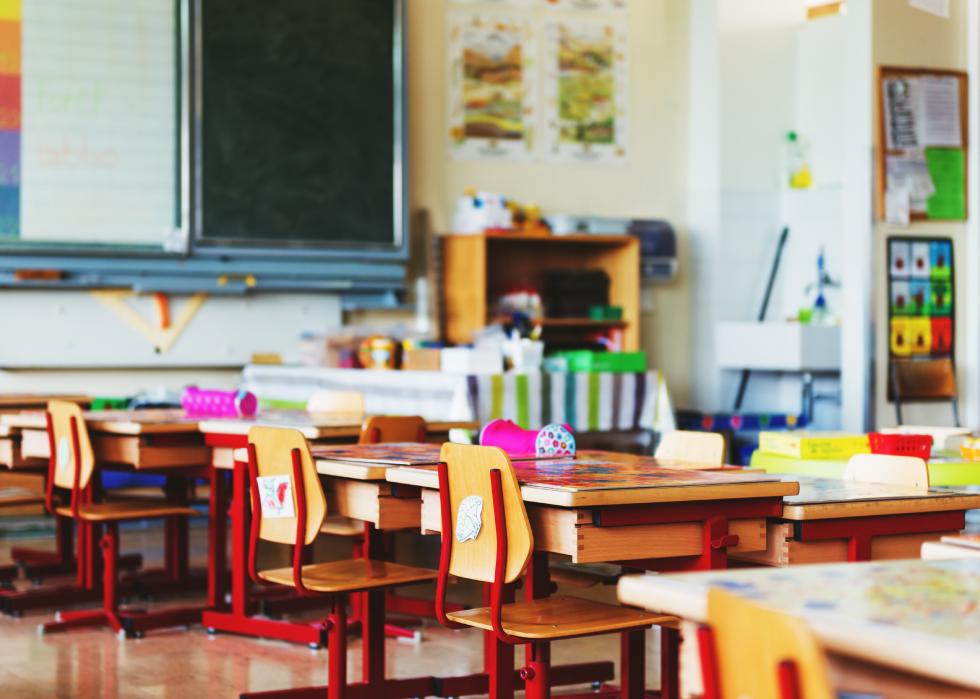
#51. Utah
- Total spending per pupil: $7,628 (39.5% less than national average)
- Salaries and wage spending: $4,367 (39.5% less than national average)
- Employee benefits spending: $2,057 (34.7% less than national average)
- Pupil support spending: $327 (56.6% less than national average)
- Instructional staff support spending: $347 (42.4% less than national average)
- General administrative spending: $81 (65.8% less than national average)
Utah has ranked last in school funding for as long as the Census Bureau has been keeping a tally—21 years. Last year voters rejected a proposal to add 10 cents a gallon to the state gas tax to raise funds for education.
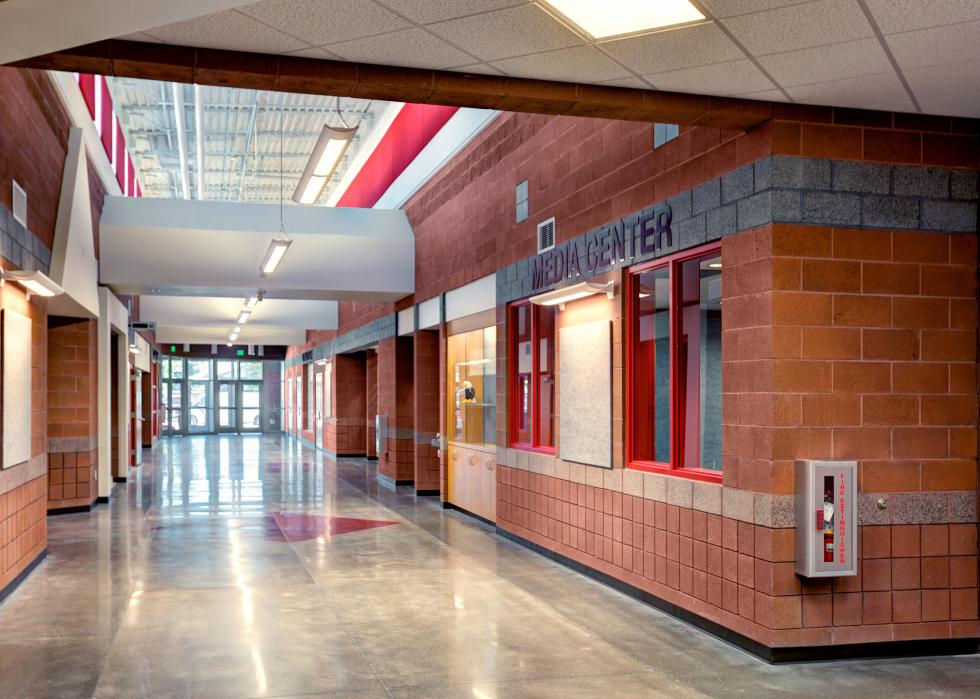
#50. Idaho
- Total spending per pupil: $7,771 (38.4% less than national average)
- Salaries and wage spending: $4,627 (35.9% less than national average)
- Employee benefits spending: $1,663 (47.2% less than national average)
- Pupil support spending: $457 (39.4% less than national average)
- Instructional staff support spending: $395 (34.4% less than national average)
- General administrative spending: $169 (28.7% less than national average)
Idaho cut $99 million from public school funding in its budget that began on July 1. But the decision was later made to restore the cuts with federal stimulus funds from the Coronavirus Aid, Relief, and Economic Security Act, known as the CARES Act. The cuts were made in the expectation that state revenues would drop dramatically, but they came in stronger than expected, state officials said.

#49. Oklahoma
- Total spending per pupil: $8,239 (34.7% less than national average)
- Salaries and wage spending: $4,475 (38% less than national average)
- Employee benefits spending: $1,606 (49% less than national average)
- Pupil support spending: $580 (23.1% less than national average)
- Instructional staff support spending: $326 (45.8% less than national average)
- General administrative spending: $251 (5.9% more than national average)
Oklahoma officials say that with rising enrollment and declining revenues due to the impact of the coronavirus pandemic, they expect to be making deep cuts in next year’s school funding. Oklahoma made cuts in education spending in the 2007–2008 recession and in 2016. It boosted its per-student education funding by 19% when teachers protested in 2018, with money for an average $6,100 pay raise for teachers, their first across-the-board increase in 10 years.
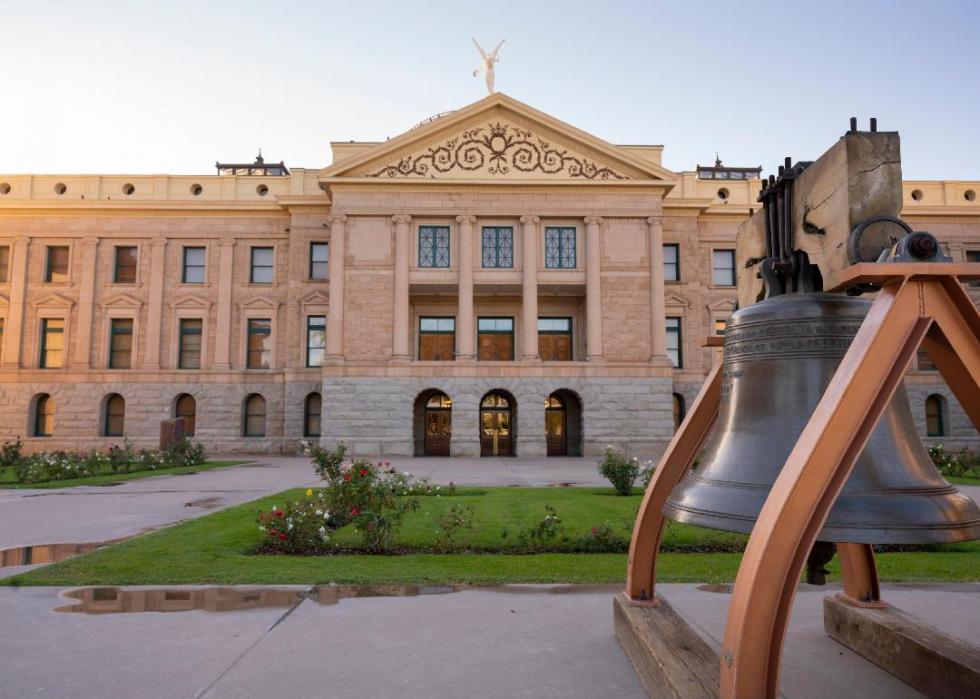
#48. Arizona
- Total spending per pupil: $8,239 (34.7% less than national average)
- Salaries and wage spending: $4,893 (32.3% less than national average)
- Employee benefits spending: $1,582 (49.8% less than national average)
- Pupil support spending: $682 (9.5% less than national average)
- Instructional staff support spending: $436 (27.6% less than national average)
- General administrative spending: $150 (36.7% less than national average)
Arizona, like a handful of other states, increased school spending after teachers protested in 2018. The state from 2008 to 2015 had cut more money from schools than any other state. It also is one of several states that does not deploy funding as a counterweight to poverty. This means it does not add funds in low-income areas, which then have less money for schools. A drop in sales tax revenues due to the coronavirus is expected to force cuts in the next budget. Some educators have said Arizona’s school buildings are in poor condition due to years without enough funding, and some districts have sued the state, claiming it is failing in its legal obligation to maintain the buildings.
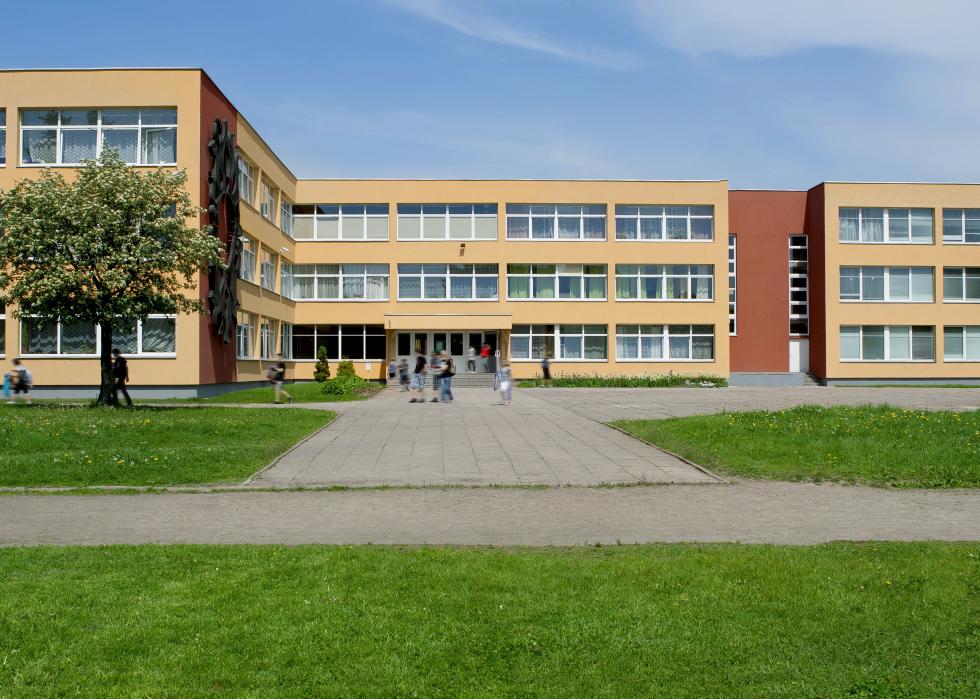
#47. Mississippi
- Total spending per pupil: $8,935 (29.2% less than national average)
- Salaries and wage spending: $5,265 (27.1% less than national average)
- Employee benefits spending: $1,785 (43.4% less than national average)
- Pupil support spending: $475 (37% less than national average)
- Instructional staff support spending: $402 (33.2% less than national average)
- General administrative spending: $311 (31.2% more than national average)
This year, Mississippi schools got a financial boost of $170 million under the $2 trillion federal Coronavirus Aid, Relief and Economic Security Act, or CARES Act. Allocation of the money was linked to the rate of low-income students, and the U.S. Department of Education recommended it be spent on remote learning, especially for disadvantaged or at-risk students.
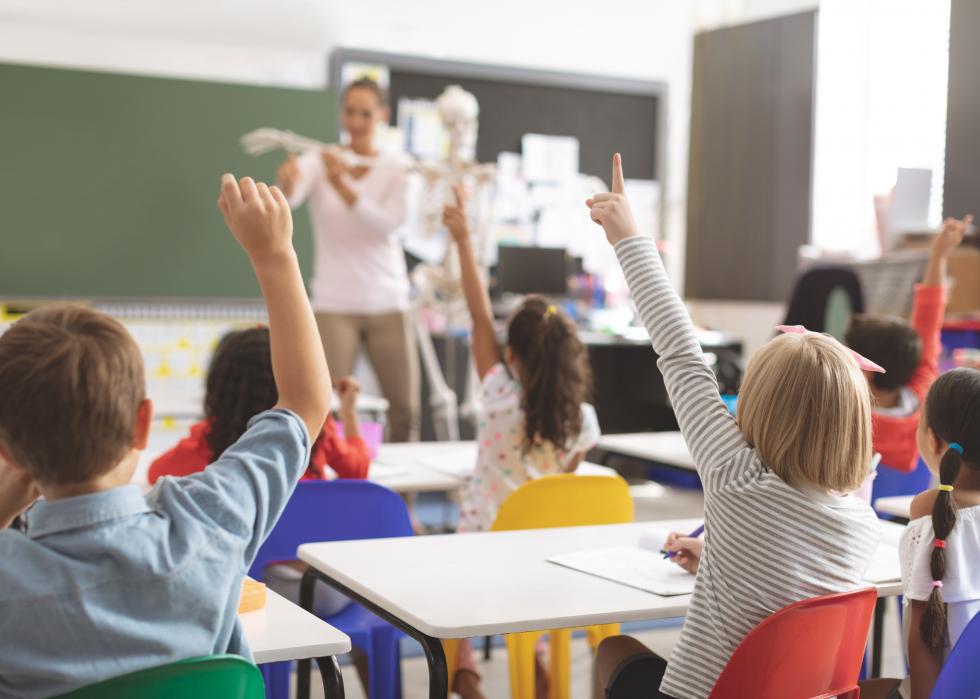
#46. Florida
- Total spending per pupil: $9,346 (25.9% less than national average)
- Salaries and wage spending: $5,219 (27.7% less than national average)
- Employee benefits spending: $1,668 (47.1% less than national average)
- Pupil support spending: $415 (45% less than national average)
- Instructional staff support spending: $568 (5.6% less than national average)
- General administrative spending: $87 (63.3% less than national average)
Voters in counties across Florida approved sales and property tax increases for education on Nov. 3. The balloting follows 21 ballot initiatives approved in 2018. Organizers of the initiatives say districts are trying to make ends meet and not getting enough money from the state. Enrollment has dropped in many school districts during the coronavirus crisis, and educators have voiced concerns that those districts will see a loss in funding that will lead to layoffs and program cuts.
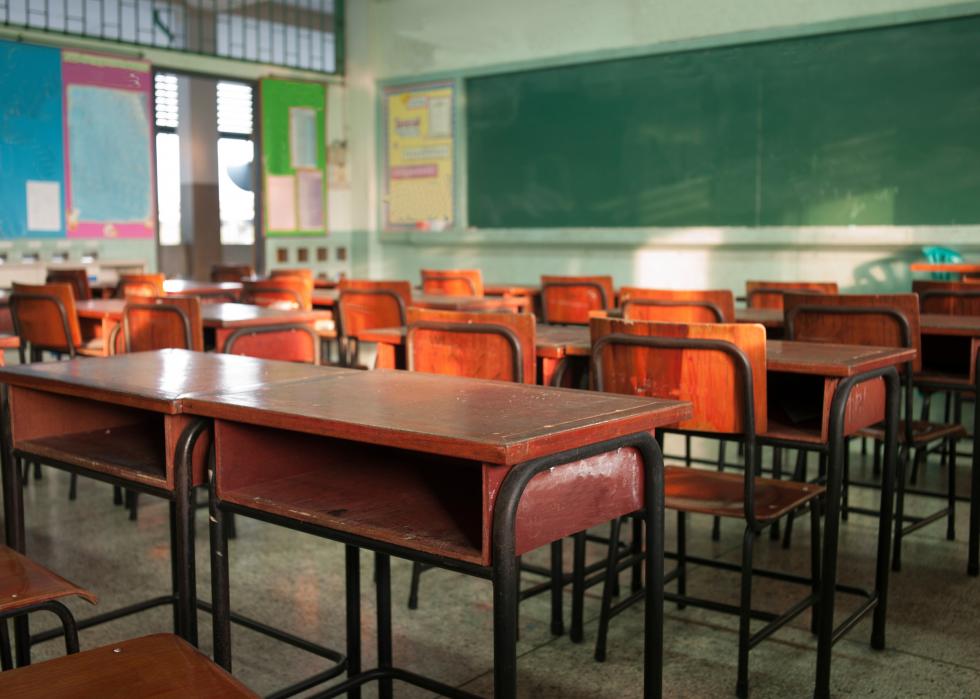
#45. North Carolina
- Total spending per pupil: $9,377 (25.7% less than national average)
- Salaries and wage spending: $5,872 (18.7% less than national average)
- Employee benefits spending: $2,071 (34.3% less than national average)
- Pupil support spending: $534 (29.2% less than national average)
- Instructional staff support spending: $330 (45.2% less than national average)
- General administrative spending: $101 (57.4% less than national average)
North Carolina lawmakers this fall approved a measure that would keep school districts from being penalized funding-wise by declining enrollment due to the coronavirus pandemic. The measure was aimed at ensuring teachers would not lose their jobs. Protests by teachers in 2018 led the state to increase school funding that it had cut deeply in the 2007–2008 recession. In North Carolina’s 2018–19 school year, state funds comprised two-thirds of the schools’ $13.9 billion operating costs.
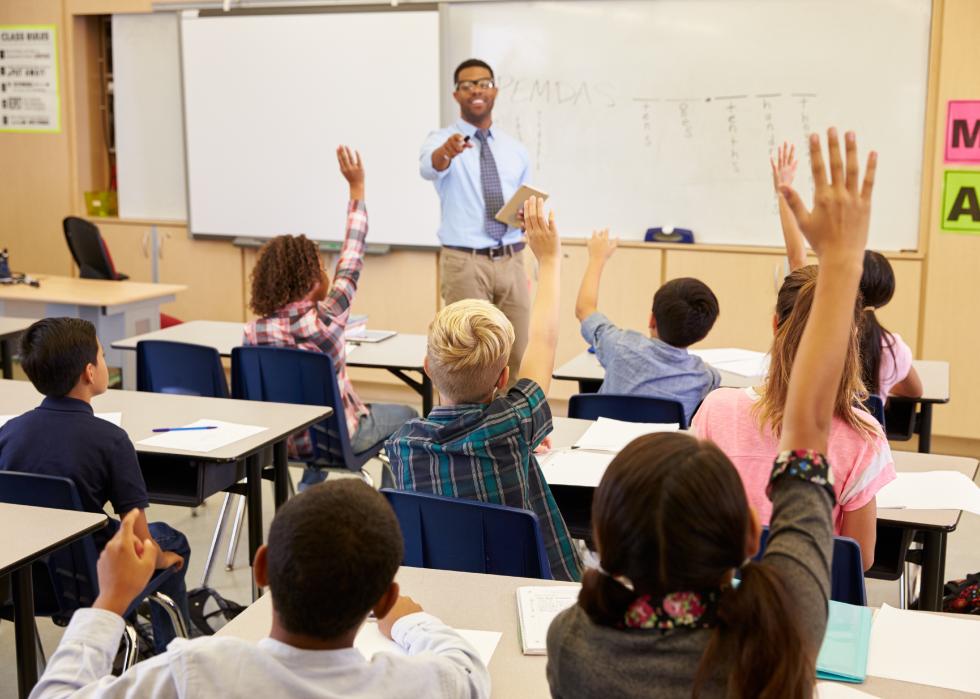
#44. Nevada
- Total spending per pupil: $9,417 (25.3% less than national average)
- Salaries and wage spending: $5,511 (23.7% less than national average)
- Employee benefits spending: $2,294 (27.2% less than national average)
- Pupil support spending: $533 (29.3% less than national average)
- Instructional staff support spending: $539 (10.5% less than national average)
- General administrative spending: $122 (48.5% less than national average)
Nevada funds its schools primarily with sales tax revenues, along with property taxes to a lesser extent, as laid out in its 2019 overhaul of its education funding formula. The overhaul measure also created the Nevada Commission on School Funding that is tasked with finding and recommending ways to pay for education. The state has just 17 districts, fewer than is typical of states its size.
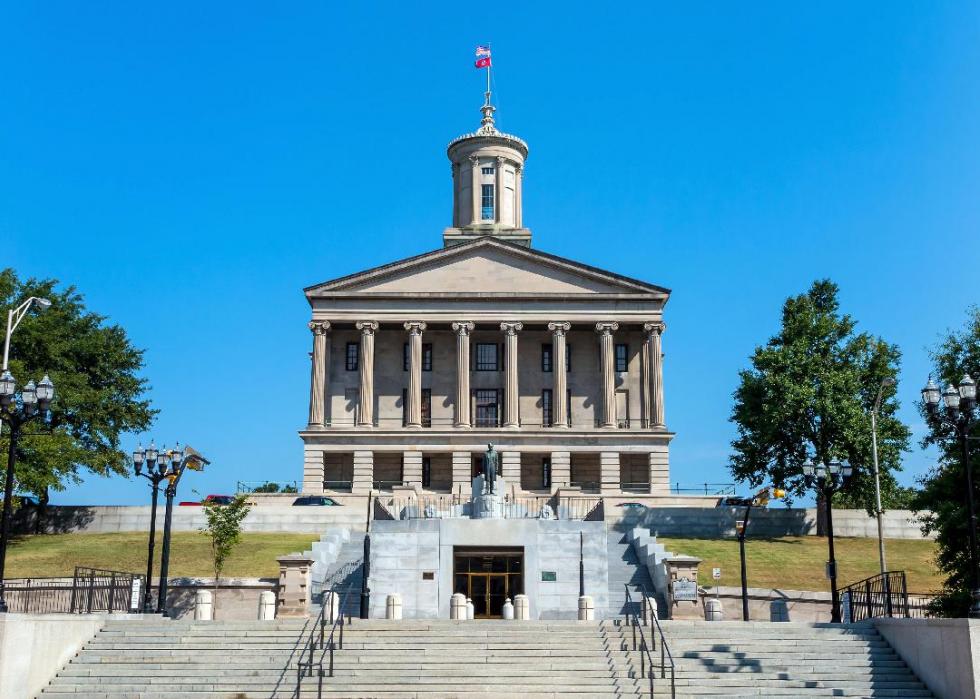
#43. Tennessee
- Total spending per pupil: $9,544 (24.3% less than national average)
- Salaries and wage spending: $5,716 (20.9% less than national average)
- Employee benefits spending: $1,885 (40.2% less than national average)
- Pupil support spending: $482 (36.1% less than national average)
- Instructional staff support spending: $566 (6% less than national average)
- General administrative spending: $204 (13.9% less than national average)
A lawsuit challenging the system of funding public schools in Tennessee is slated to go to trial in October 2021 after being filed five years ago. In the suit, school districts in Memphis and Nashville claim the state does not allocate enough money for education, particularly in urban areas. Tennessee’s system came under criticism by a national advocacy group that said its poorer districts have lower staffing, higher student-teacher ratios, and a lack of counselors, social workers, and psychologists.

#42. New Mexico
- Total spending per pupil: $9,582 (24% less than national average)
- Salaries and wage spending: $5,671 (21.5% less than national average)
- Employee benefits spending: $2,036 (35.4% less than national average)
- Pupil support spending: $991 (31.4% more than national average)
- Instructional staff support spending: $245 (59.3% less than national average)
- General administrative spending: $204 (13.9% less than national average)
New Mexico voters approved bonds for education in the Nov. 3 election. The measures included capital improvement funding to tribal schools and schools for hearing and visually impaired students, such as the New Mexico School for the Deaf and the Navajo Technical University, a major tribal college. In 2018, voters also approved bond measures to fund tribal schools, new school buses, and books, electronics and broadband upgrades for public schools. Roughly a quarter of New Mexico's school-age children live in poverty.
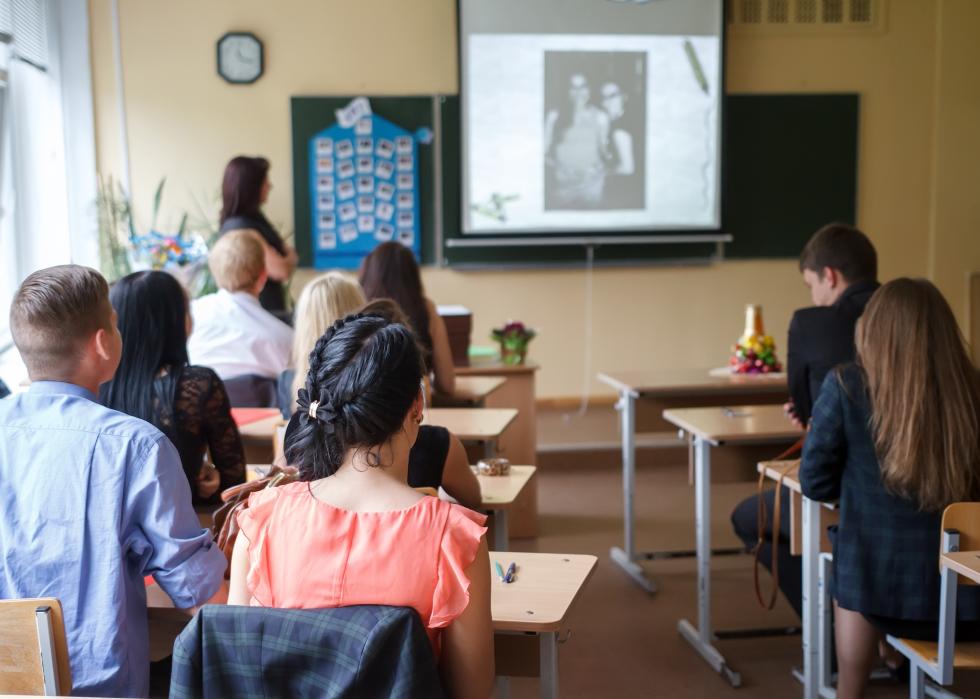
#41. Texas
- Total spending per pupil: $9,606 (23.8% less than national average)
- Salaries and wage spending: $6,548 (9.3% less than national average)
- Employee benefits spending: $1,171 (62.8% less than national average)
- Pupil support spending: $500 (33.7% less than national average)
- Instructional staff support spending: $505 (16.1% less than national average)
- General administrative spending: $145 (38.8% less than national average)
Texas education officials have been weighing alternatives to the system for funding schools, which like many states is based on attendance. Enrollment is down, in part due to job losses and evictions. One district in the Houston area has seen a drop in enrollment of some 3,400 students, off 7.5%. Most of the state’s 5.5 million public school students are learning remotely, but data from spring showed more than 10% were not participating at all. Without changes to the funding system, many school districts will take a huge financial hit.
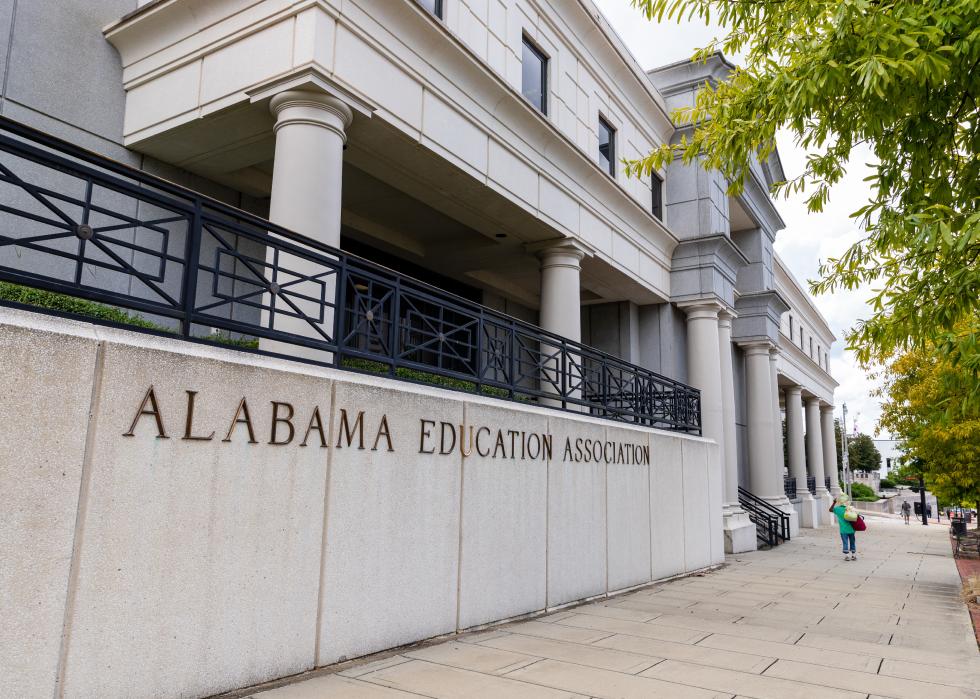
#40. Alabama
- Total spending per pupil: $9,696 (23.1% less than national average)
- Salaries and wage spending: $5,417 (25% less than national average)
- Employee benefits spending: $2,188 (30.6% less than national average)
- Pupil support spending: $622 (17.5% less than national average)
- Instructional staff support spending: $396 (34.2% less than national average)
- General administrative spending: $250 (5.5% more than national average)
Alabama’s most recent state budget allocated $7.2 billion in funds for education, its biggest ever, but one that omitted several anticipated increases due to the economic impact of the coronavirus. A proposed 3% raise in teachers’ salaries, which would have cost $135 million, was dropped, as was a proposed increase of $27 million for school transportation. A $25 million proposal to increase pre-K funding was whittled down to $3 million, and money for classroom technology, supplies, and textbooks was trimmed. Nearly all the money in the state’s education funding is derived from income and sales taxes.
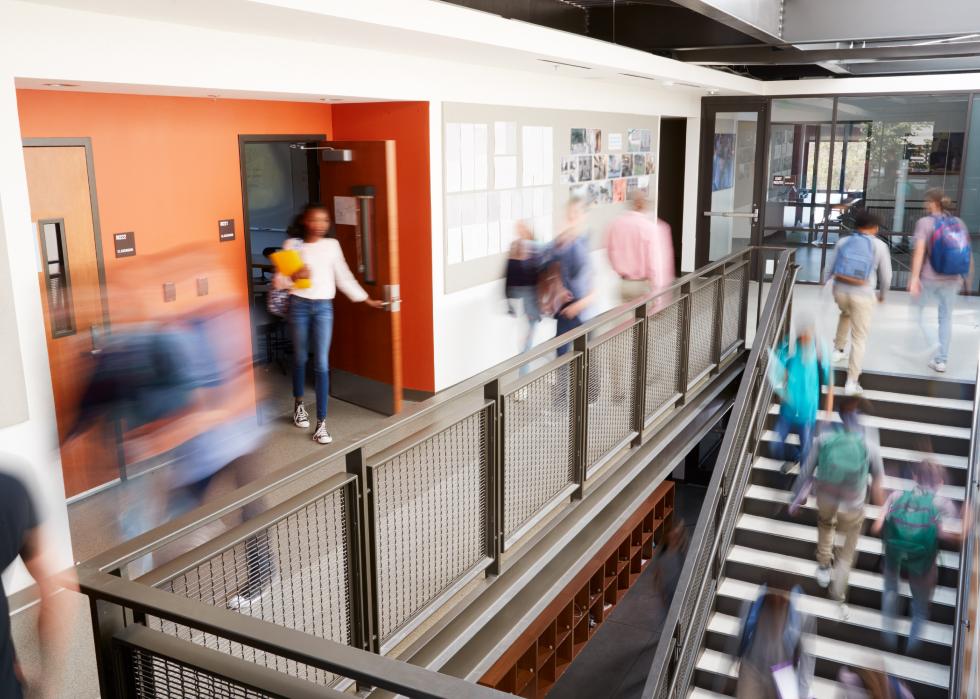
#39. South Dakota
- Total spending per pupil: $10,073 (20.1% less than national average)
- Salaries and wage spending: $6,050 (16.2% less than national average)
- Employee benefits spending: $1,773 (43.7% less than national average)
- Pupil support spending: $561 (25.6% less than national average)
- Instructional staff support spending: $367 (39% less than national average)
- General administrative spending: $346 (46% more than national average)
By state law, South Dakota is required to increase its school funding each year by whichever is less—3% or the Consumer Price Index, which measures inflation. This year, it increased spending by 2%, based on the CPI. The funding system was set up in 2017 as a way to boost teachers’ pay after it also raised the sales tax to 4.5% from 4% for school funding.
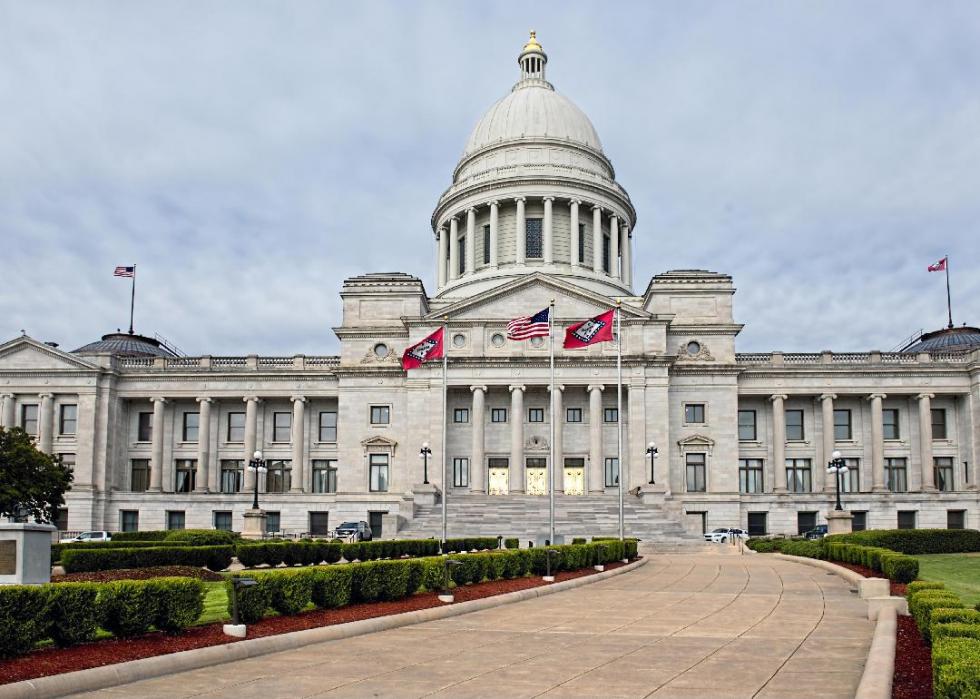
#38. Arkansas
- Total spending per pupil: $10,139 (19.6% less than national average)
- Salaries and wage spending: $5,921 (18% less than national average)
- Employee benefits spending: $1,680 (46.7% less than national average)
- Pupil support spending: $549 (27.2% less than national average)
- Instructional staff support spending: $833 (38.4% more than national average)
- General administrative spending: $244 (3% more than national average)
Legislative committees in Arkansas made recommendations in October that the state boost funding for public schools by $99.7 million in fiscal 2022 and $86.9 million in the following year. Their recommendations are required every two years under a 2003 law passed after the state Supreme Court ruled in 2002 that Arkansas’ system of funding its schools was inadequate, inequitable, and violated the state’s constitution.

#37. Colorado
- Total spending per pupil: $10,202 (19.1% less than national average)
- Salaries and wage spending: $6,267 (13.2% less than national average)
- Employee benefits spending: $1,959 (37.8% less than national average)
- Pupil support spending: $602 (20.2% less than national average)
- Instructional staff support spending: $592 (1.7% less than national average)
- General administrative spending: $162 (31.6% less than national average)
Lawmakers in Colorado this year cut funding plans for higher teachers' salaries, school construction, additional social workers, anti-dropout programs, and stronger school safety in the 2020–2021 budget after the impact of the coronavirus on state revenues left a projected shortfall of $3.3 billion. The cuts were similar to those of the 2007–2008 recession.
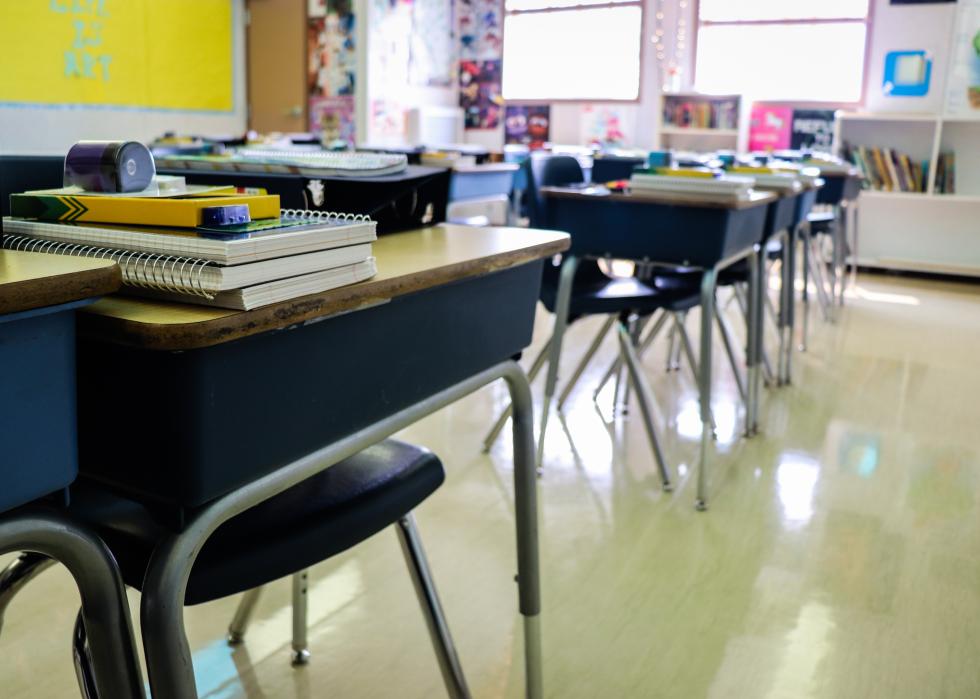
#36. Indiana
- Total spending per pupil: $10,262 (18.6% less than national average)
- Salaries and wage spending: $5,634 (22% less than national average)
- Employee benefits spending: $3,044 (3.4% less than national average)
- Pupil support spending: $535 (29% less than national average)
- Instructional staff support spending: $404 (32.9% less than national average)
- General administrative spending: $208 (12.2% less than national average)
Schools in Indiana’s low-income communities get far less funding than those in more affluent areas, and students with disabilities and with English as a second language are getting less funding as well, according to new research. The gap between rich and poor schools has grown since property tax reforms were implemented in 2008 that require districts to get voter approval via referendums in order to levy new taxes, it said. Referendums are more successful in wealthier districts, it said. In the Nov. 3 election, however, voters in Gary, a mostly Black city in which a third of the population lives in poverty, approved a referendum to raise taxes for school funding. Officials said a priority would be salary increases for teachers who haven’t gotten raises in more than a decade.
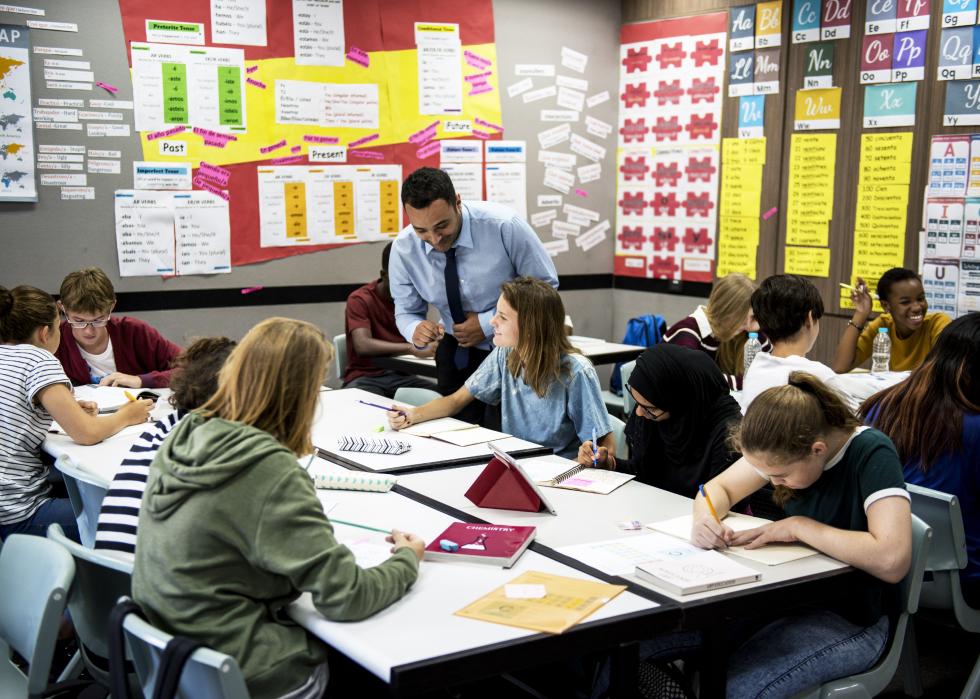
#35. Missouri
- Total spending per pupil: $10,810 (14.3% less than national average)
- Salaries and wage spending: $6,628 (8.2% less than national average)
- Employee benefits spending: $2,082 (33.9% less than national average)
- Pupil support spending: $487 (35.4% less than national average)
- Instructional staff support spending: $477 (20.8% less than national average)
- General administrative spending: $426 (79.7% more than national average)
Missouri made deep spending cuts to its state budget this summer, due to the coronavirus pandemic, that slashed funding to schools. Elementary schools are getting $123 million less than what had been budgeted. State officials said the drop in revenues was worse than that of the recession in 2007–2008.

#34. Georgia
- Total spending per pupil: $10,810 (14.3% less than national average)
- Salaries and wage spending: $6,352 (12.1% less than national average)
- Employee benefits spending: $2,568 (18.5% less than national average)
- Pupil support spending: $577 (23.5% less than national average)
- Instructional staff support spending: $561 (6.8% less than national average)
- General administrative spending: $136 (42.6% less than national average)
Georgia schools lost roughly $1 billion in funding this year when lawmakers approved a state budget that lopped off 11%, or some $2.6 billion, in spending cuts. The revenue shortfall was the consequence of the coronavirus pandemic on the economy, lawmakers said. Georgia has been making significant cuts to schools for the past decade, losing teaching slots and adding to class sizes, critics say.

#33. South Carolina
- Total spending per pupil: $10,856 (13.9% less than national average)
- Salaries and wage spending: $6,167 (14.6% less than national average)
- Employee benefits spending: $2,444 (22.4% less than national average)
- Pupil support spending: $889 (17.9% more than national average)
- Instructional staff support spending: $702 (16.6% more than national average)
- General administrative spending: $100 (57.8% less than national average)
South Carolina increased its spending on teachers’ salaries and per-student funding in 2019–2020, according to the state’s yearly school report card. The analysis found local, state, and federal spending rose more than $600 per student, or roughly 6%, and that the average teacher’s salary rose almost 5%. It also said the total number of teachers rose, and teacher retention improved.
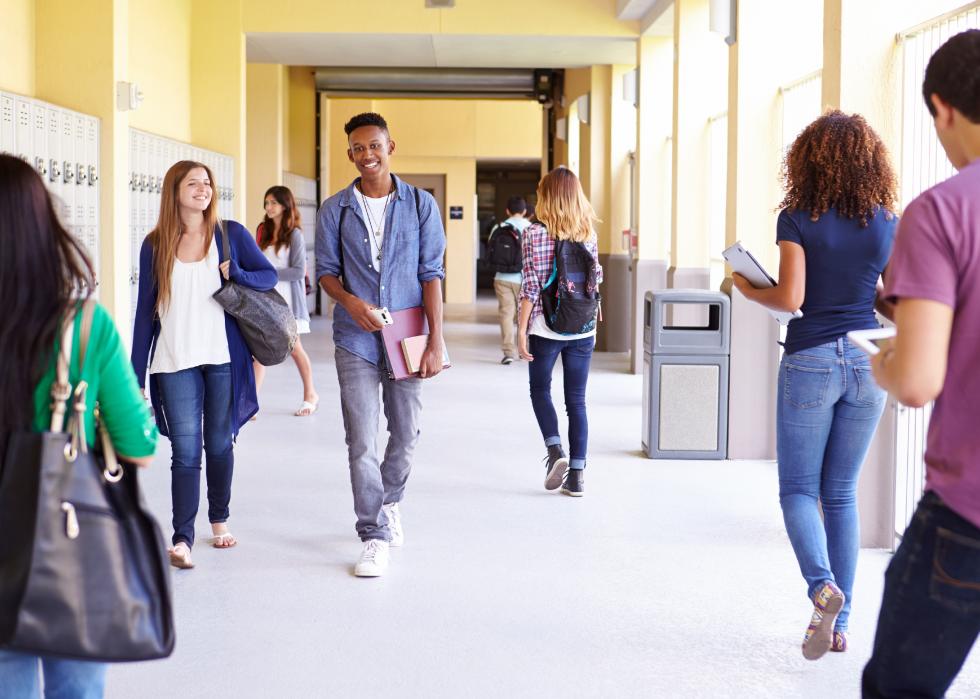
#32. Kentucky
- Total spending per pupil: $11,110 (11.9% less than national average)
- Salaries and wage spending: $6,206 (14.1% less than national average)
- Employee benefits spending: $3,381 (7.3% more than national average)
- Pupil support spending: $543 (28% less than national average)
- Instructional staff support spending: $623 (3.5% more than national average)
- General administrative spending: $250 (5.5% more than national average)
The gap in funding between poor and wealthy districts is growing, according to research released in September by the Kentucky Center for Economic Policy, a research group that found affluent districts had $2,840 more per student in state and local revenue than did poor districts last year. A lack of adequate funding resulted in larger class sizes, outdated transportation, cuts in classes like art, music, and dance, and decaying infrastructure, critics say, before the impacts of the coronavirus pandemic made the economic situation more dire.
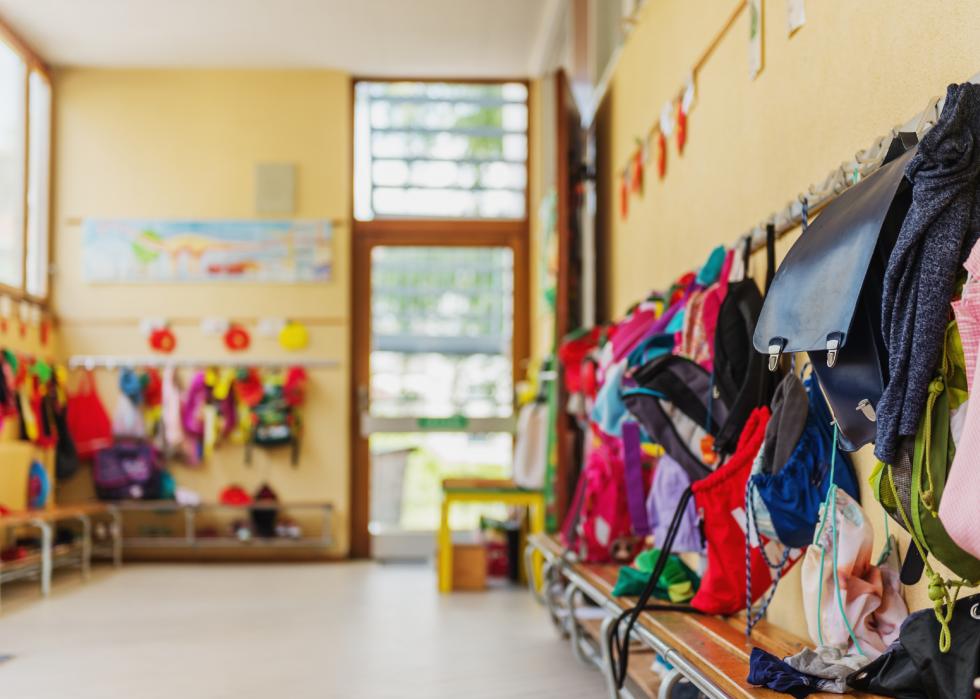
#31. West Virginia
- Total spending per pupil: $11,334 (10.1% less than national average)
- Salaries and wage spending: $6,194 (14.2% less than national average)
- Employee benefits spending: $3,289 (4.4% more than national average)
- Pupil support spending: $599 (20.6% less than national average)
- Instructional staff support spending: $411 (31.7% less than national average)
- General administrative spending: $189 (20.3% less than national average)
A teachers’ strike in West Virginia was one of the most effective of the job actions that swept through the nation in the spring of 2018. Schools were closed for nine days for the walkout until the governor signed a bill agreeing to give teachers a 5% raise. The teachers had defied calls to go back to work until the promise of a raise was signed into law. The estimated cost for the raises for teachers and other state workers was $110 million a year.
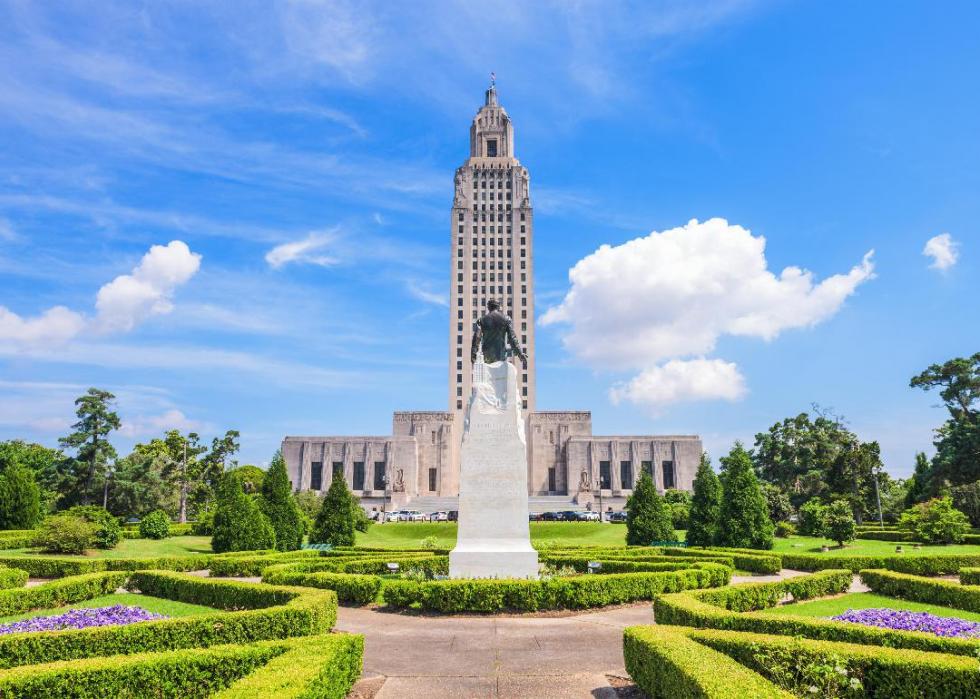
#30. Louisiana
- Total spending per pupil: $11,452 (9.2% less than national average)
- Salaries and wage spending: $6,109 (15.4% less than national average)
- Employee benefits spending: $3,187 (1.1% more than national average)
- Pupil support spending: $725 (3.8% less than national average)
- Instructional staff support spending: $589 (2.2% less than national average)
- General administrative spending: $297 (25.3% more than national average)
Louisiana voters on Nov. 3 rejected a proposed constitutional amendment that would have played a role in how schools are funded. The proposal would have allowed businesses to negotiate upfront payments with local governments in exchange for longer-term tax reductions. Opponents that included civic and grassroots organizations said it would allow businesses and politicians to cut backroom deals and cost badly needed revenue for schools. It was backed by the Louisiana School Boards Association. Supporters said the measure would have been useful for local governments to get revenues early, as many new and expanding companies can be exempt from property taxes for as long as 10 years.
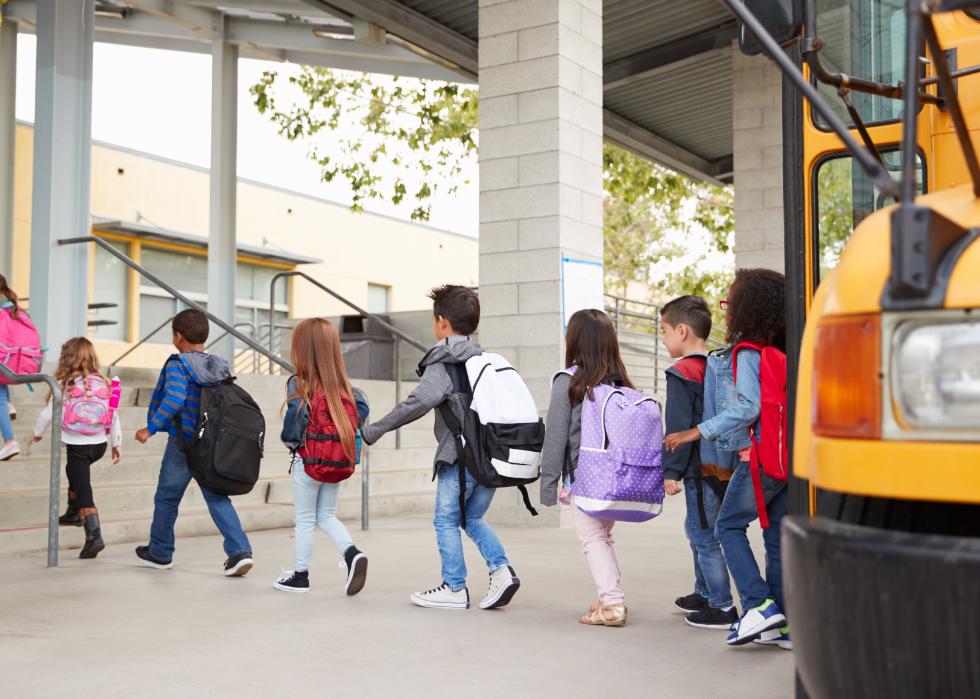
#29. Kansas
- Total spending per pupil: $11,653 (7.6% less than national average)
- Salaries and wage spending: $6,821 (5.6% less than national average)
- Employee benefits spending: $2,262 (28.2% less than national average)
- Pupil support spending: $723 (4.1% less than national average)
- Instructional staff support spending: $468 (22.3% less than national average)
- General administrative spending: $297 (25.3% more than national average)
Kansas officials said in October that school funding would be allocated among far fewer students, in that some 25,000 students have withdrawn from public schools not offering in-person learning full time. Statewide enrollment is estimated at about 451,000 students, less than the enrollment level of a decade ago. Funding to schools will not drop, however, after districts successfully lobbied the legislature so that money will be allotted based on previous enrollment.
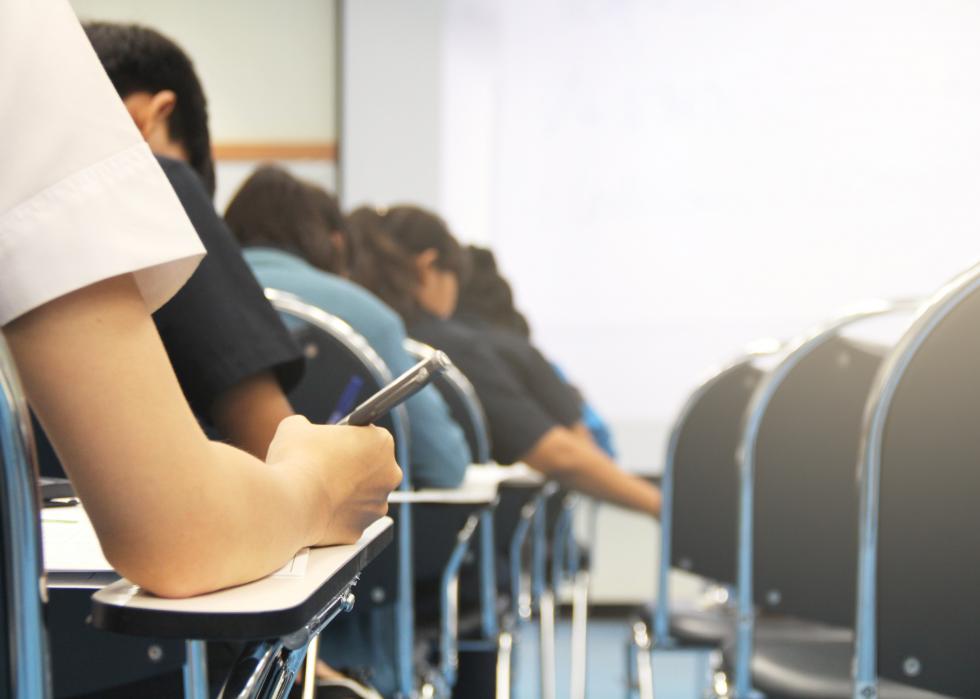
#28. Montana
- Total spending per pupil: $11,680 (7.4% less than national average)
- Salaries and wage spending: $6,810 (5.7% less than national average)
- Employee benefits spending: $2,126 (32.5% less than national average)
- Pupil support spending: $810 (7.4% more than national average)
- Instructional staff support spending: $425 (29.4% less than national average)
- General administrative spending: $353 (48.9% more than national average)
In the Nov. 3 election, voters elected an all-Republican slate of candidates as governor, all statewide offices, and in growing majorities in both the state House and Senate. Proposals on the party agenda include shifting some funding for public education to private schools. State Republicans have backed a plan to provide tuition grants and tax credits to private and parochial schools. Opponents say cuts in property tax and a Republican plan to freeze state spending will leave little room for higher teacher salaries.

#27. Iowa
- Total spending per pupil: $11,732 (7% less than national average)
- Salaries and wage spending: $7,463 (3.3% more than national average)
- Employee benefits spending: $2,507 (20.4% less than national average)
- Pupil support spending: $695 (7.8% less than national average)
- Instructional staff support spending: $736 (22.3% more than national average)
- General administrative spending: $296 (24.9% more than national average)
Iowa's current budget of more than $212 million, which began with its fiscal year on July 1, included an additional 29 classroom teaching positions with a price tag of $2.1 million. It also added teachers for preschool, special education, and talented and gifted programs for $600,000. Lawmakers negotiate the next budget, to be adopted in mid-April, over the winter and spring.
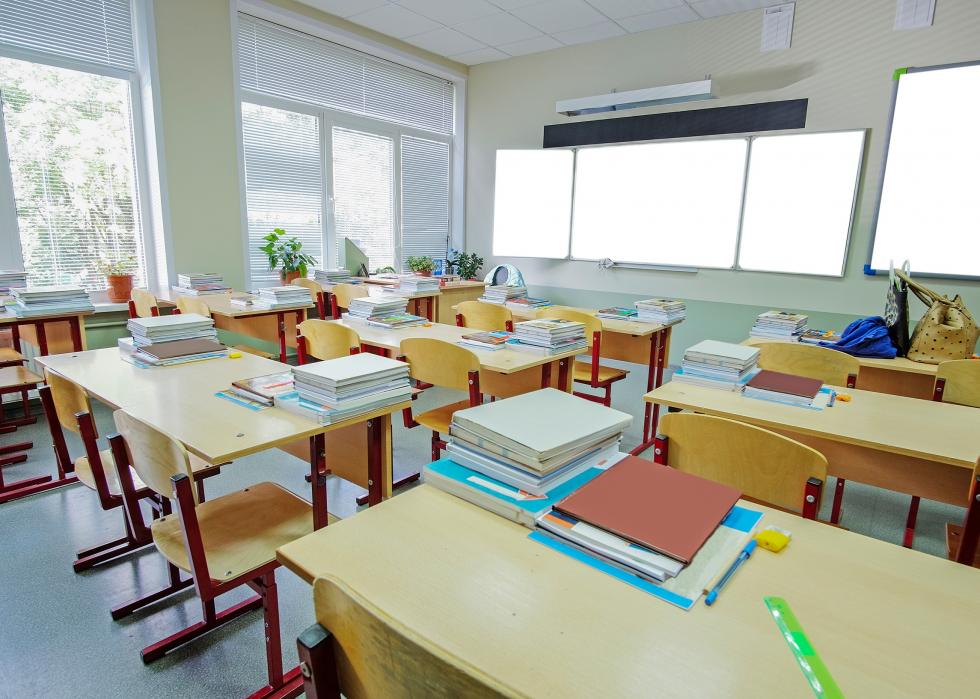
#26. Oregon
- Total spending per pupil: $11,920 (5.5% less than national average)
- Salaries and wage spending: $6,205 (14.1% less than national average)
- Employee benefits spending: $3,580 (13.6% more than national average)
- Pupil support spending: $933 (23.7% more than national average)
- Instructional staff support spending: $473 (21.4% less than national average)
- General administrative spending: $166 (30% less than national average)
Voters in Oregon approved 14 out of 17 bonds and local option levies for school spending in the Nov. 3 election. The biggest was a $1.2 billion bond issue by the Portland School District for funding to finish modernizing its high schools and investment in a Center for Black Student Excellence. A bond proposal in a school district east of Eugene, Oregon, lost after the local school board passed a resolution calling on the community to vote no, saying it was wrong to ask additional money from residents who were recovering from the state’s devastating Holiday Farm wildfire in September that destroyed hundreds of homes.
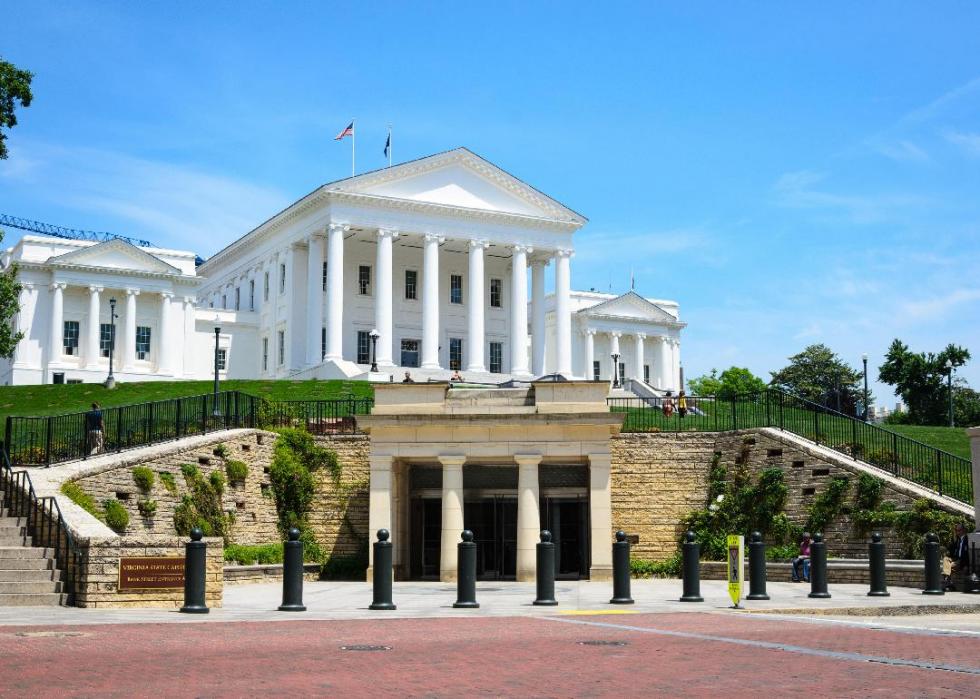
#25. Virginia
- Total spending per pupil: $12,216 (3.1% less than national average)
- Salaries and wage spending: $7,461 (3.3% more than national average)
- Employee benefits spending: $3,151 (0% more than national average)
- Pupil support spending: $629 (16.6% less than national average)
- Instructional staff support spending: $821 (36.4% more than national average)
- General administrative spending: $198 (16.5% less than national average)
A state government report released in October showed Virginia needed to use more funding to recruit and retain teachers. It found about 1% of teaching positions statewide were not filled, but that the rate was uneven and as high as 8% and 15% in some districts. It also showed about 7% of teaching jobs were filled by teachers who have only provisional licenses. Educators said recruitment and retention would need to be addressed by pay increases, but lawmakers scrapped plans for raises due to revenue shortfalls linked to the coronavirus pandemic.
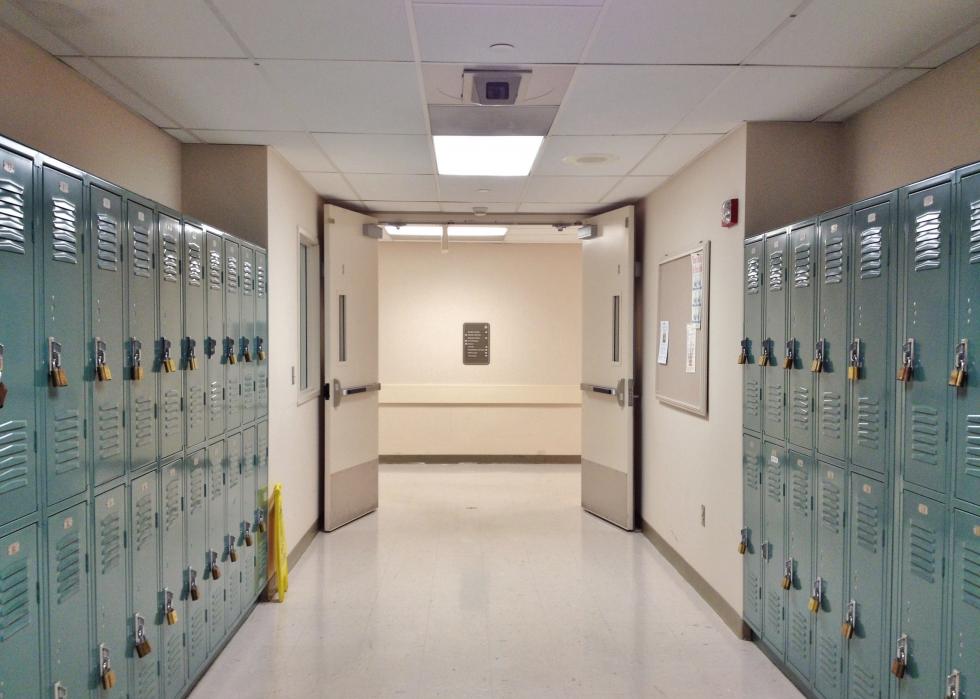
#24. Wisconsin
- Total spending per pupil: $12,285 (2.6% less than national average)
- Salaries and wage spending: $6,738 (6.7% less than national average)
- Employee benefits spending: $2,902 (7.9% less than national average)
- Pupil support spending: $606 (19.6% less than national average)
- Instructional staff support spending: $646 (7.3% more than national average)
- General administrative spending: $332 (40.1% more than national average)
School districts in Wisconsin are facing drops in funding this year due to lower enrollment, as the state’s system is enrollment-based. Overall, enrollment dropped 3%, by more than 25,000 students, officials said in the fall of 2020, with declines of 6% in Green Bay, an urban area, and as much as 35% in rural Washington, Wisconsin, in Door County. Almost a third of the state’s 421 public districts will see a decline in state aid due to decreased enrollment, according to officials.
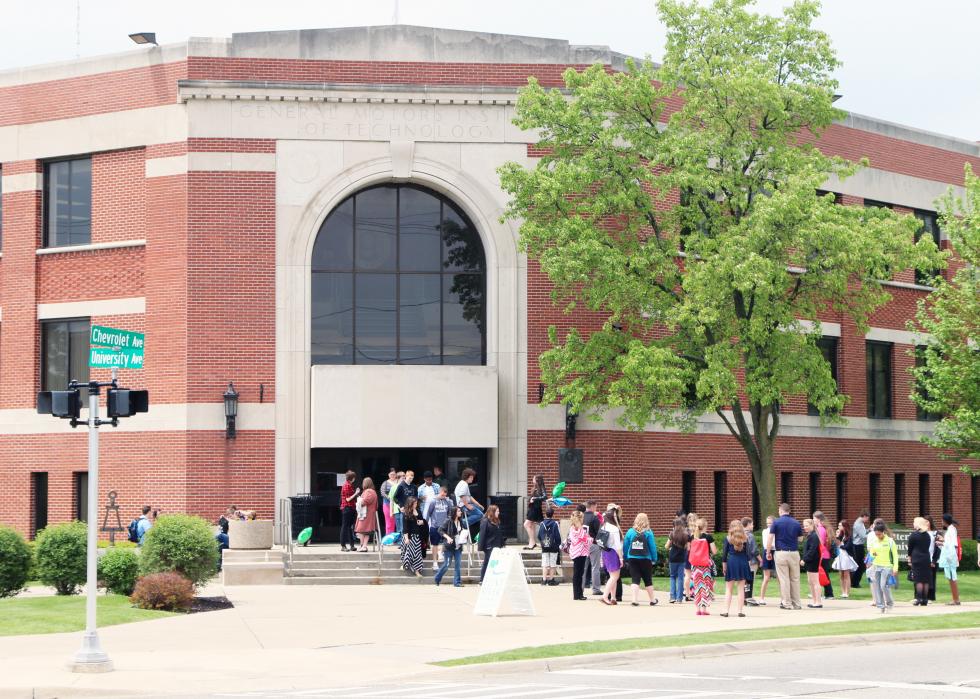
#23. Michigan
- Total spending per pupil: $12,345 (2.1% less than national average)
- Salaries and wage spending: $5,963 (17.4% less than national average)
- Employee benefits spending: $4,042 (28.3% more than national average)
- Pupil support spending: $1,024 (35.8% more than national average)
- Instructional staff support spending: $626 (4% more than national average)
- General administrative spending: $207 (12.7% less than national average)
Michigan approved a 2021 budget in September that featured a per-student funding increase of $65, thanks in part to federal funds and better-than-expected tax revenues. It also provided for school lunches and hazard pay for teachers and for support staff.

#22. Nebraska
- Total spending per pupil: $12,491 (1% less than national average)
- Salaries and wage spending: $7,352 (1.8% more than national average)
- Employee benefits spending: $2,712 (13.9% less than national average)
- Pupil support spending: $491 (34.9% less than national average)
- Instructional staff support spending: $433 (28.1% less than national average)
- General administrative spending: $368 (55.3% more than national average)
Spending on public schools in Nebraska has increased in dollar amounts over the past decade or more, relying ever-increasingly on local property taxes, but as a portion of personal income, it has declined. In 2018, Nebraska residents spent less on education per $1,000 of personal income than they spent in 1993. Teacher salaries are the most costly item, but comprise a smaller share than in the past. This year, Nebraska got $12.5 million in federal education money under the CARES act and bought more than 25,000 laptops and tablets for rural schools where students did not have the devices they needed for remote learning.

#21. California
- Total spending per pupil: $12,498 (0.9% less than national average)
- Salaries and wage spending: $7,053 (2.4% less than national average)
- Employee benefits spending: $3,410 (8.2% more than national average)
- Pupil support spending: $775 (2.8% more than national average)
- Instructional staff support spending: $753 (25.1% more than national average)
- General administrative spending: $126 (46.8% less than national average)
California has bigger class sizes and fewer counselors than most other U.S. states, and its student-to-staff ratios are among the highest, according to research released in 2019. Its teachers’ salaries are low, given the state’s cost of living and compared to other workers with similar education. The research also found that in the late 1960s, California residents contributed 4% of their personal income to school funding, and that share has dropped to 3.2%, a $16.6 billion difference.
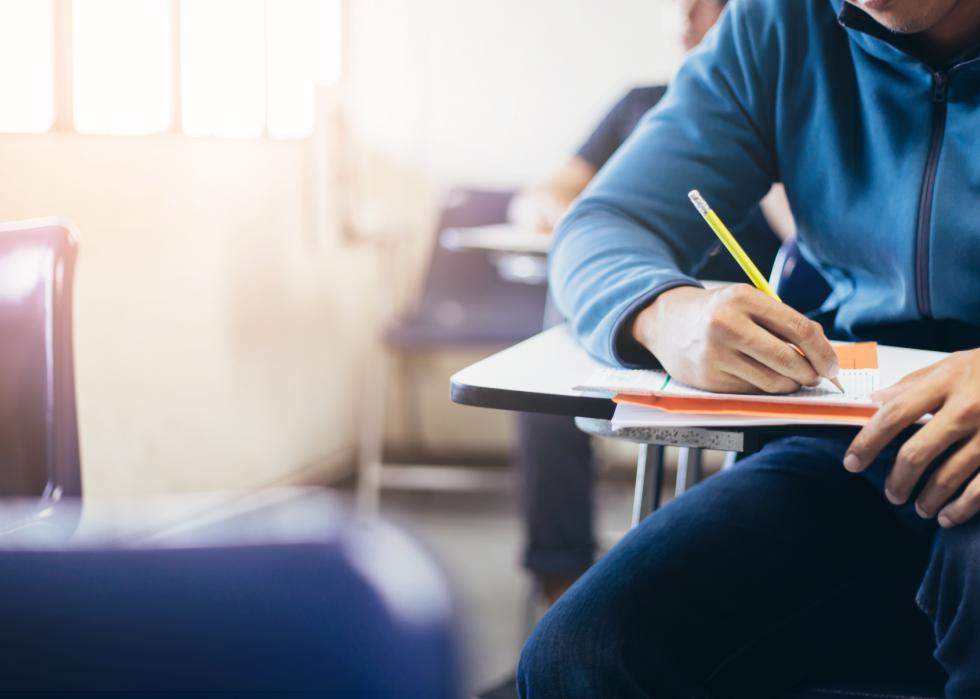
#20. Minnesota
- Total spending per pupil: $12,975 (2.9% more than national average)
- Salaries and wage spending: $8,159 (13% more than national average)
- Employee benefits spending: $2,762 (12.3% less than national average)
- Pupil support spending: $395 (47.6% less than national average)
- Instructional staff support spending: $664 (10.3% more than national average)
- General administrative spending: $467 (97% more than national average)
In Minnesota, voters on Nov. 3 approved about half—17 out of 33—of the operating levies proposed by local districts to supplement federal and state funding impacted by the coronavirus pandemic. It was the lowest rate of approval since 2008, during the recession. Educators said some of the funds would have covered technology costs for remote learning, such as wireless networks, classroom software, hotspots and data plans to help students with unreliable internet access, and data protection.
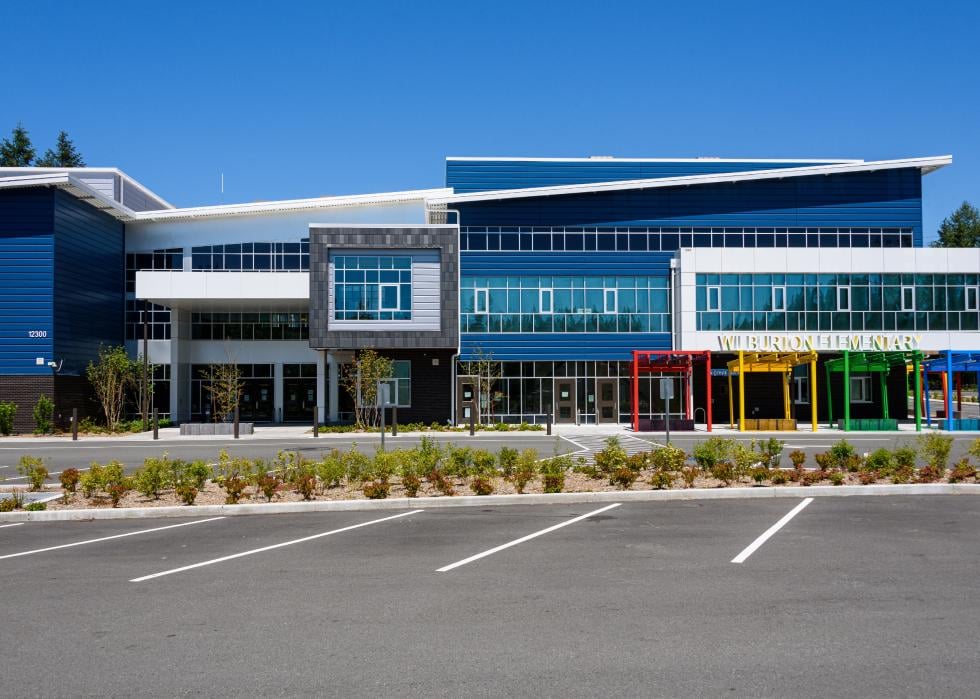
#19. Washington
- Total spending per pupil: $12,995 (3% more than national average)
- Salaries and wage spending: $7,787 (7.8% more than national average)
- Employee benefits spending: $3,026 (4% less than national average)
- Pupil support spending: $951 (26.1% more than national average)
- Instructional staff support spending: $895 (48.7% more than national average)
- General administrative spending: $136 (42.6% less than national average)
A drop in enrollment in Washington state schools this fall will likely lead to funding cuts in 2021, officials say. The state had almost 3% fewer students in the fall of 2020, compared with 2019. A third of the decline was fewer students in kindergarten, an enrollment drop of more than 14%, as families kept young children home due to the coronavirus pandemic. The trends mean the possibility of a boom in attendance next year, officials say. Washington school funding is based on enrollment.
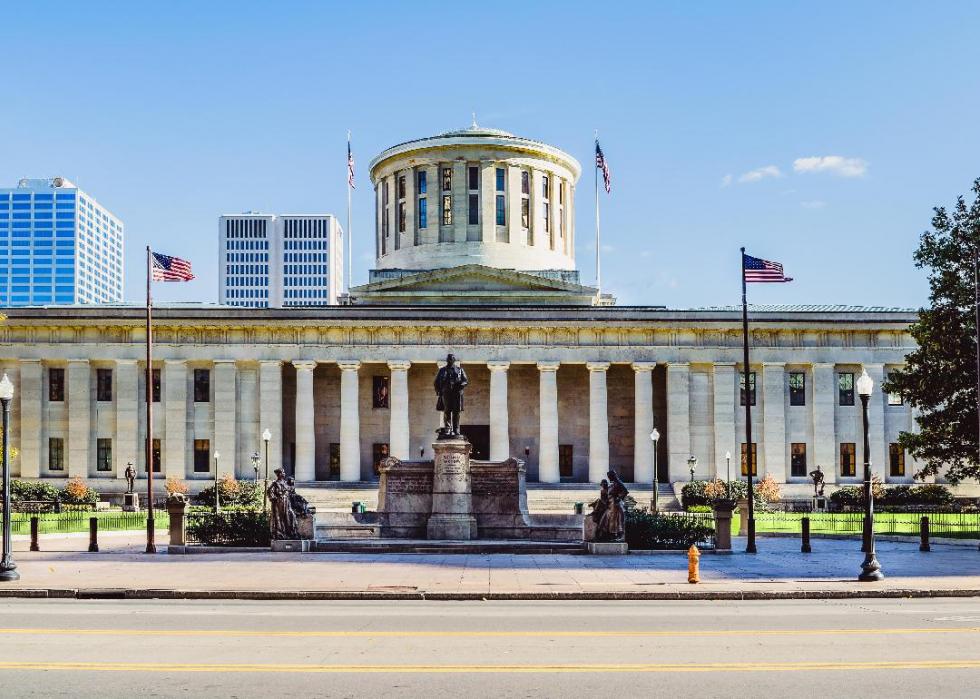
#18. Ohio
- Total spending per pupil: $13,027 (3.3% more than national average)
- Salaries and wage spending: $7,513 (4% more than national average)
- Employee benefits spending: $2,934 (6.9% less than national average)
- Pupil support spending: $925 (22.7% more than national average)
- Instructional staff support spending: $522 (13.3% less than national average)
- General administrative spending: $371 (56.5% more than national average)
Lawmakers in late 2020 were weighing changes to the state’s school funding system, the latest legislative attempt to answer a 1997 Ohio Supreme Court ruling that found its system unconstitutional. The court has reaffirmed that ruling three times since. The state is expecting a budget shortfall in 2021 due to the economic impacts of the coronavirus pandemic.
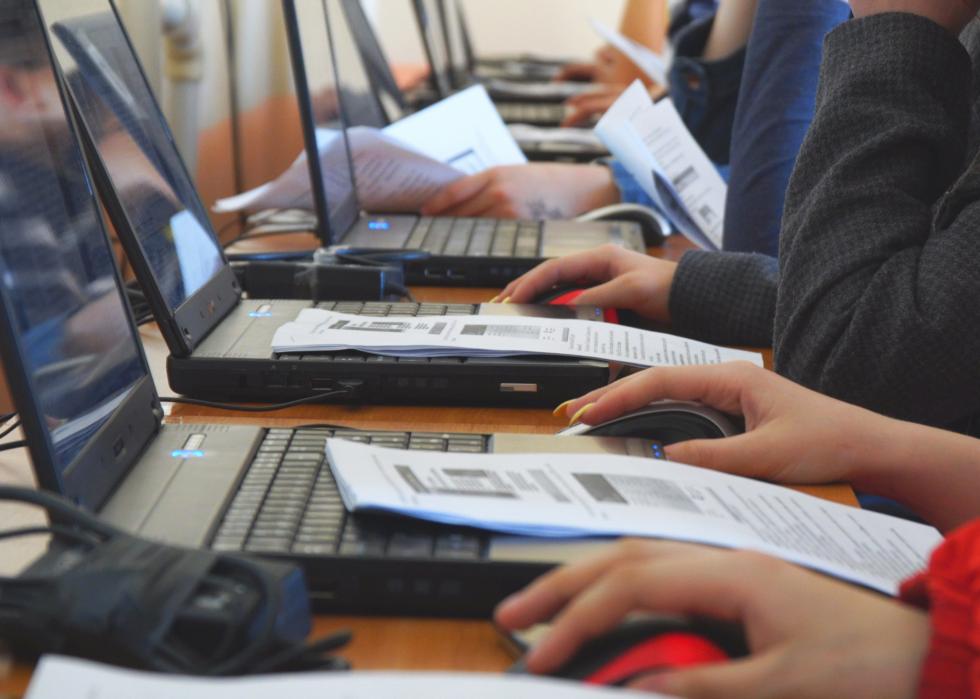
#17. North Dakota
- Total spending per pupil: $13,758 (9.1% more than national average)
- Salaries and wage spending: $8,280 (14.6% more than national average)
- Employee benefits spending: $3,071 (2.5% less than national average)
- Pupil support spending: $564 (25.2% less than national average)
- Instructional staff support spending: $482 (19.9% less than national average)
- General administrative spending: $606 (155.7% more than national average)
Lawmakers in North Dakota divvied up more than $31 million in federal funding for schools in September. Nearly all the money went to an Education Corps fund for school districts to cover staffing expenses, with other funds going to a software learning program that can be tailored for individual students to learn in math, reading, and English. Another $500,000 was allocated to help families who could not afford broadband service for remote learning.
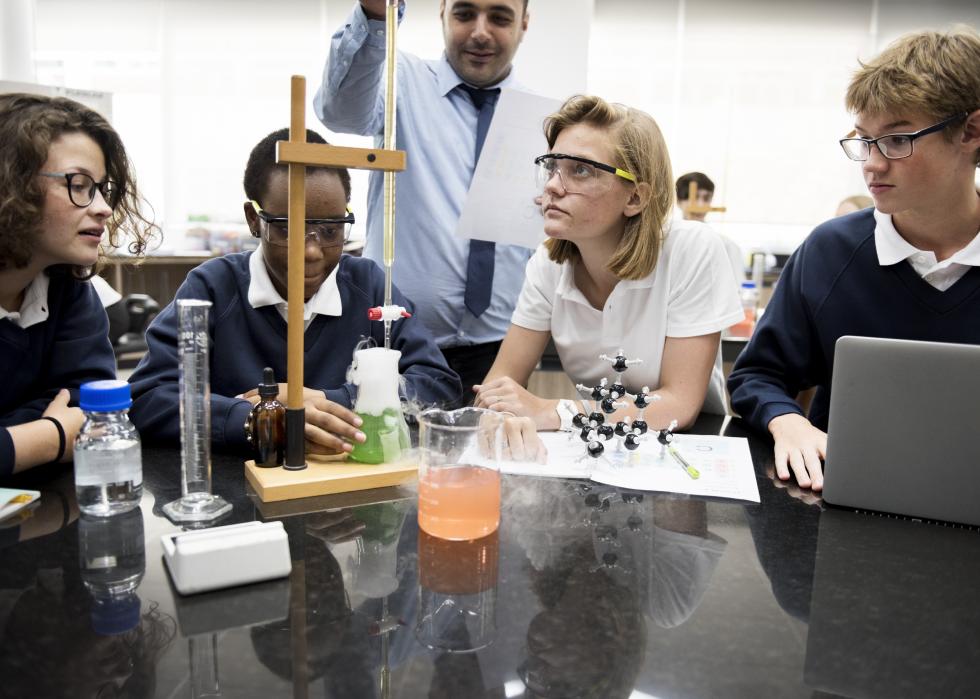
#16. Maine
- Total spending per pupil: $14,145 (12.2% more than national average)
- Salaries and wage spending: $8,492 (17.6% more than national average)
- Employee benefits spending: $3,409 (8.2% more than national average)
- Pupil support spending: $1,040 (37.9% more than national average)
- Instructional staff support spending: $722 (19.9% more than national average)
- General administrative spending: $610 (157.4% more than national average)
Maine allotted $329 million of its CARES Act relief funds to schools in 2020. Districts were spending the funds on personal protective equipment, desks, added staff, and air ionization systems. A report released by an education nonprofit and the state Chamber of Commerce in October said the state needed to boost funding, particularly for its economically disadvantaged students. It said the state had an increase in the number of students from low-income households since the 2008 recession, and that the economic impact of the coronavirus pandemic would surely add to their ranks.
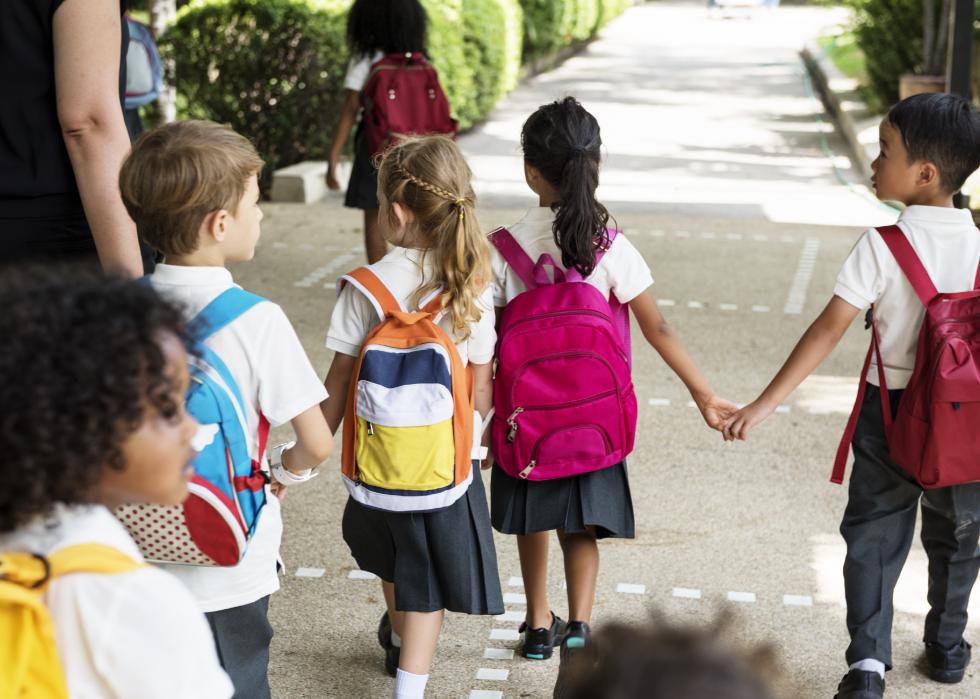
#15. Maryland
- Total spending per pupil: $14,762 (17% more than national average)
- Salaries and wage spending: $10,391 (43.9% more than national average)
- Employee benefits spending: $3,859 (22.5% more than national average)
- Pupil support spending: $692 (8.2% less than national average)
- Instructional staff support spending: $747 (24.1% more than national average)
- General administrative spending: $106 (55.3% less than national average)
In March of 2020, Maryland’s state legislature passed an education funding formula called the Kirwan Commission that called for increasing education spending by $4 billion a year. Supporters said Maryland’s economy depends upon a highly educated workforce that attracts business and well-paying jobs. The measure was vetoed by Gov. Larry Hogan, who said the state could not afford the added spending due to the impacts of the coronavirus.
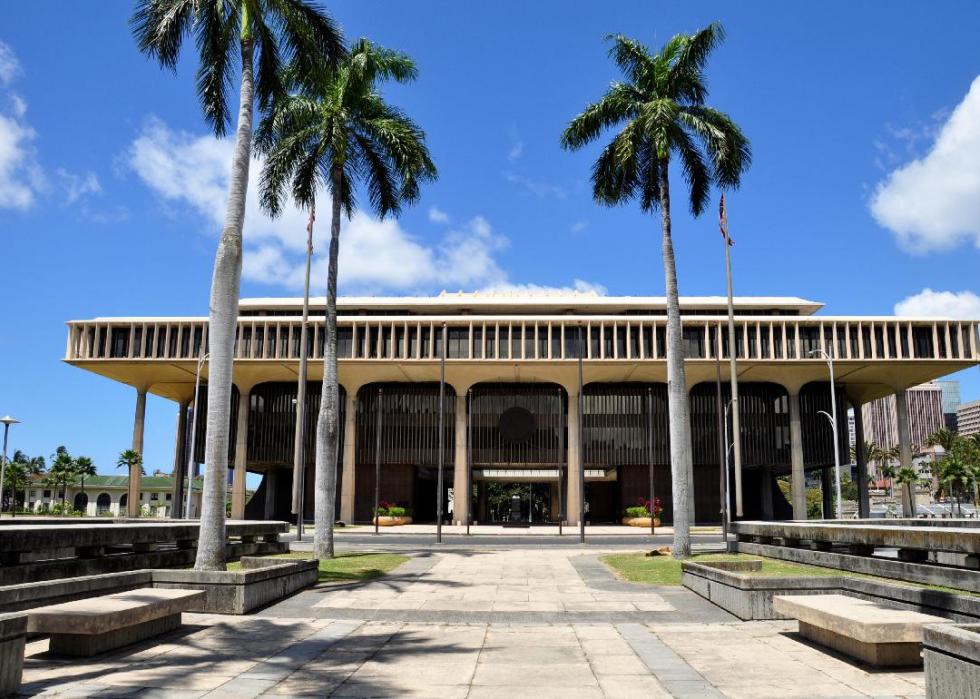
#14. Hawaii
- Total spending per pupil: $15,242 (20.9% more than national average)
- Salaries and wage spending: $8,057 (11.5% more than national average)
- Employee benefits spending: $4,047 (28.4% more than national average)
- Pupil support spending: $1,445 (91.6% more than national average)
- Instructional staff support spending: $525 (12.8% less than national average)
- General administrative spending: $78 (67.1% less than national average)
Hawaii’s school funding faces an $84 million shortfall in the fiscal year that began on July 1. The cuts affect items related to the coronavirus pandemic such as digital devices, remote learning platforms, and personal protective equipment. In 2019, the state approved $27 million for pay increases to hard-to-staff teaching positions including special education teachers, Hawaiian language immersion teachers, and teachers in remote areas. The increases range as high as $8,000 a year for remote and Hawaiian immersion teachers and $10,000 for special education teachers. Hawaii typically faces a teacher shortage that leaves about 1,000 positions vacant every year.
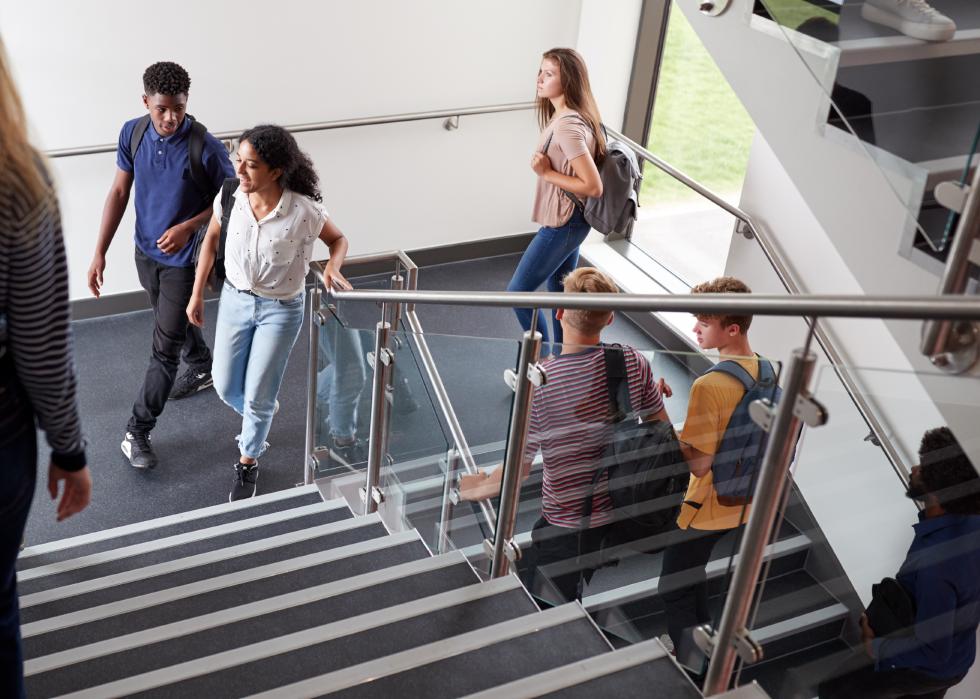
#13. Delaware
- Total spending per pupil: $15,639 (24% more than national average)
- Salaries and wage spending: $8,345 (15.5% more than national average)
- Employee benefits spending: $4,491 (42.5% more than national average)
- Pupil support spending: $758 (0.5% more than national average)
- Instructional staff support spending: $273 (54.7% less than national average)
- General administrative spending: $183 (22.8% less than national average)
Delaware settled a lawsuit in October that accused the state of providing inadequate resources to low-income students, students with disabilities, and students learning English as a second language. The lawsuit took issue with a funding formula that critics claimed favored districts with growing enrollment and penalized poorer districts. The settlement included more funding for English learners and low-income students, special education, early childhood programs, and recruitment and retention efforts.
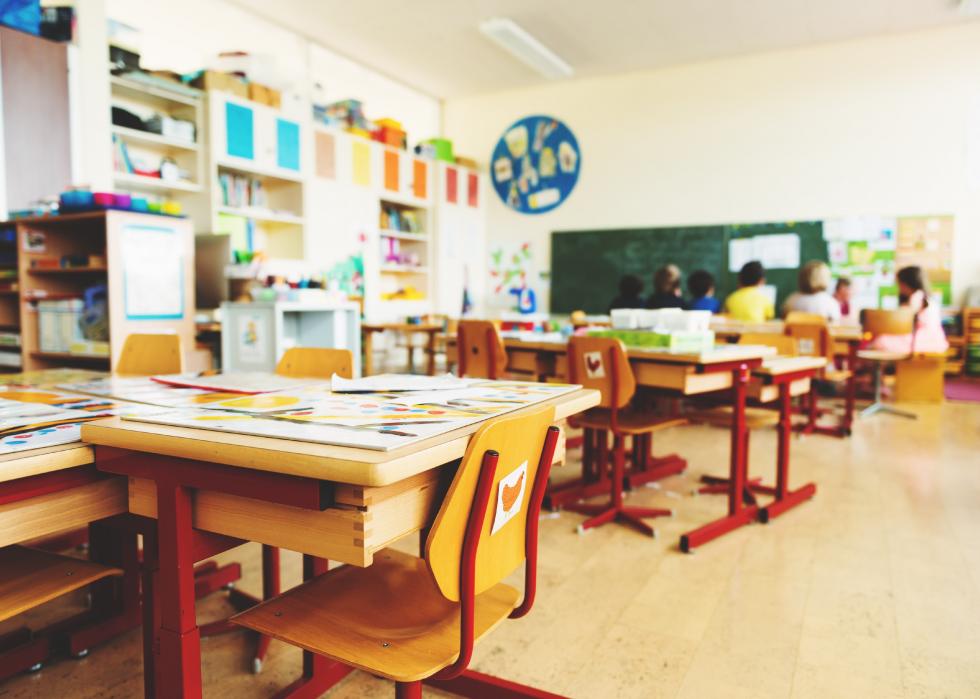
#12. Illinois
- Total spending per pupil: $15,741 (24.8% more than national average)
- Salaries and wage spending: $7,641 (5.8% more than national average)
- Employee benefits spending: $5,989 (90.1% more than national average)
- Pupil support spending: $1,131 (50% more than national average)
- Instructional staff support spending: $586 (2.7% less than national average)
- General administrative spending: $598 (152.3% more than national average)
The budget passed in Illinois in 2020 kept school funding flat, to the concern of education officials worried about higher costs linked to smaller classes, deep cleanings, additional buses for social distancing, and health and safety practices. Illinois school districts spent their share of federal stimulus money on digital devices and broadband access, mostly for low-income students.

#11. Rhode Island
- Total spending per pupil: $16,121 (27.8% more than national average)
- Salaries and wage spending: $9,486 (31.3% more than national average)
- Employee benefits spending: $4,390 (39.3% more than national average)
- Pupil support spending: $1,891 (150.8% more than national average)
- Instructional staff support spending: $681 (13.1% more than national average)
- General administrative spending: $230 (3.0% less than national average)
A report released in October 2020 by the Rhode Island Public Expenditure Council (RIPEC) pointed to a rise in inequity among public schools since the coronavirus reached the state—a fact made more troubling by the fact that Rhode Island ranks highly overall for how much it invests in its students. Only nine of the 36 districts ordered by Gov. Gina Raimondo to open by Oct. 13 did so, with schools offering in-person learning more prevalent in wealthier neighborhoods and towns. Many of those districts that did not meet the deadline are also lower-performing schools in general, and remote learning is expected to only exacerbate those shortcomings. RIPEC's recommendations included ensuring that all Rhode Island students have access to broadband internet and devices such as computers. In 2020, $50 million more in funding was made available with supplemental budgeting; the majority of those funds were distributed to lower-income districts.

#10. Wyoming
- Total spending per pupil: $16,224 (28.6% more than national average)
- Salaries and wage spending: $9,417 (30.4% more than national average)
- Employee benefits spending: $4,250 (34.9% more than national average)
- Pupil support spending: $1,001 (32.8% more than national average)
- Instructional staff support spending: $822 (36.5% more than national average)
- General administrative spending: $313 (32.1% more than national average)
Looking at a $515 million funding gap for Wyoming schools, due to the coronavirus pandemic and weak energy prices, the state was considering the possibility of a 1 cent sales tax proposed by the Wyoming School Board Association. Opponents said such a tax could harm consumers and small businesses, while supporters said it could raise revenue more quickly than property taxes, and that the burden would be shared by out-of-state residents. Wyoming in 2020 was undergoing an education recalibration, a process held every five years to study its school system and how to fund it. The recalibration fulfills a constitutional mandate for the state to provide quality education.
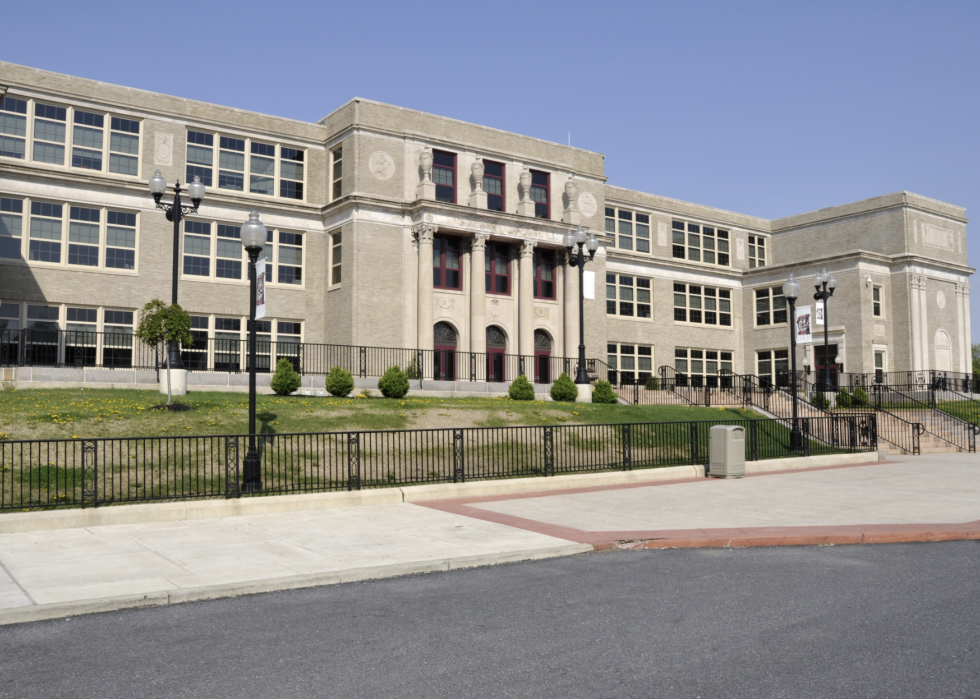
#9. Pennsylvania
- Total spending per pupil: $16,395 (30% more than national average)
- Salaries and wage spending: $8,232 (14% more than national average)
- Employee benefits spending: $5,319 (68.8% more than national average)
- Pupil support spending: $932 (23.6% more than national average)
- Instructional staff support spending: $611 (1.5% more than national average)
- General administrative spending: $442 (86.5% more than national average)
New research in October, prepared as part of a long-running lawsuit to address inequities in the state’s school funding, disclosed dramatic disparities in education spending in Pennsylvania. The report noted that Pennsylvania relies heavily on local taxes for school funding, so lower-income districts have less money. On average, the poorest one-fifth of districts have $7,866 less per student than the richest one-fifth, it said. Some 86% of students go to public schools that lack adequate funding, it said.
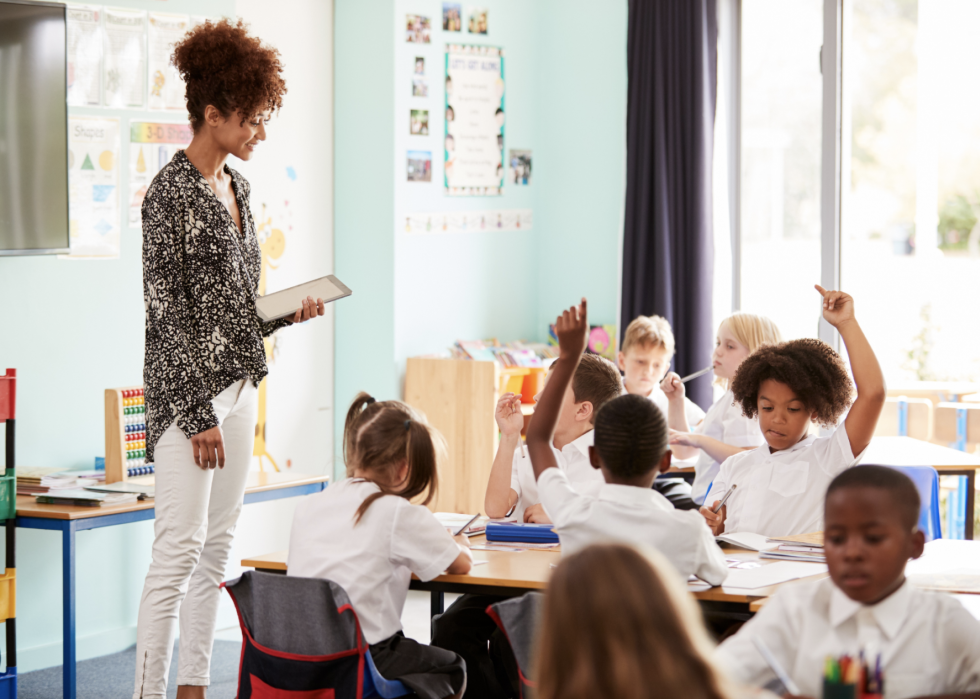
#8. New Hampshire
- Total spending per pupil: $16,893 (33.9% more than national average)
- Salaries and wage spending: $9,035 (25.1% more than national average)
- Employee benefits spending: $4,375 (38.8% more than national average)
- Pupil support spending: $1,351 (79.2% more than national average)
- Instructional staff support spending: $555 (7.8% less than national average)
- General administrative spending: $614 (159.1% more than national average)
An independent study of New Hampshire’s schools released this year said the state system produced funding discrepancies for students, putting low-income students, English learners, and special education students at a disadvantage. It said that a weighted system, which would fund schools according to the costs they face, would better support high-need districts.

#7. Massachusetts
- Total spending per pupil: $17,058 (35.3% more than national average)
- Salaries and wage spending: $10,632 (47.2% more than national average)
- Employee benefits spending: $4,251 (34.9% more than national average)
- Pupil support spending: $1,342 (78% more than national average)
- Instructional staff support spending: $828 (37.5% more than national average)
- General administrative spending: $204 (13.9% less than national average)
Legislation passed last year in Massachusetts, the Student Opportunity Act, was set to add $1.5 billion to public school funding over seven years. But the economic blows of the coronavirus pandemic put the funding in question. An advocacy group of Massachusetts businesses recently recommended the state change its funding formula after finding that nearly $500 million of needs-blind state aid was going to the state's wealthiest one-fifth of school districts.
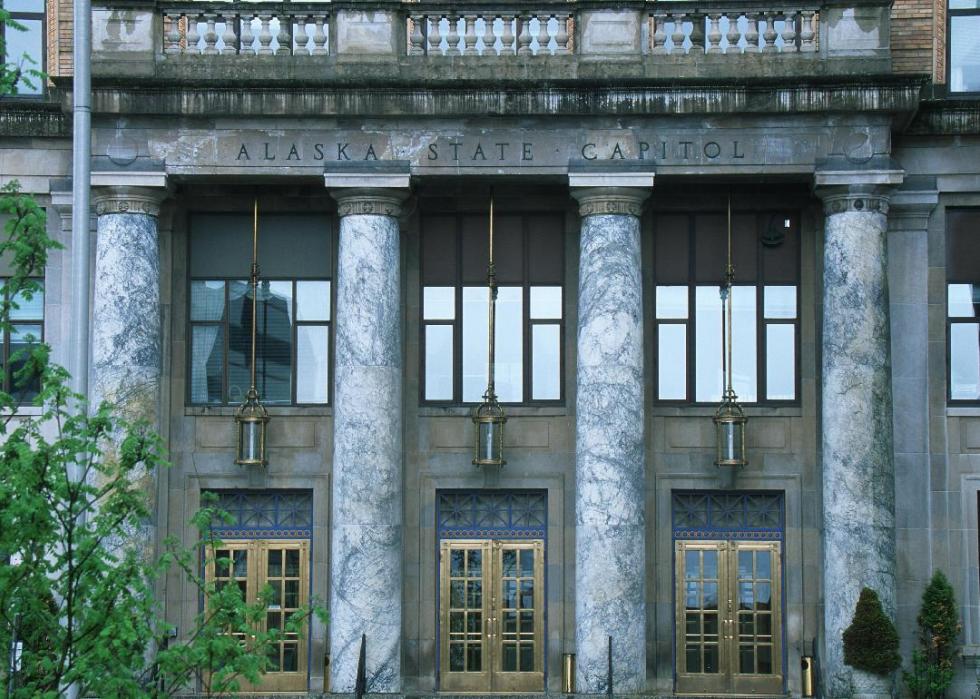
#6. Alaska
- Total spending per pupil: $17,726 (40.5% more than national average)
- Salaries and wage spending: $8,386 (16.1% more than national average)
- Employee benefits spending: $4,934 (56.6% more than national average)
- Pupil support spending: $1,364 (80.9% more than national average)
- Instructional staff support spending: $1,436 (138.5% more than national average)
- General administrative spending: $260 (9.7% more than national average)
Because school funding is enrollment-based in Alaska, districts with dramatically declining student populations this year due to the coronavirus pandemic are facing steep cuts. The Juneau School District, having lost almost 11% of its student enrollment, stands to lose about $358,000. Anchorage schools could lose more than $30 million due to several thousand fewer students enrolling.
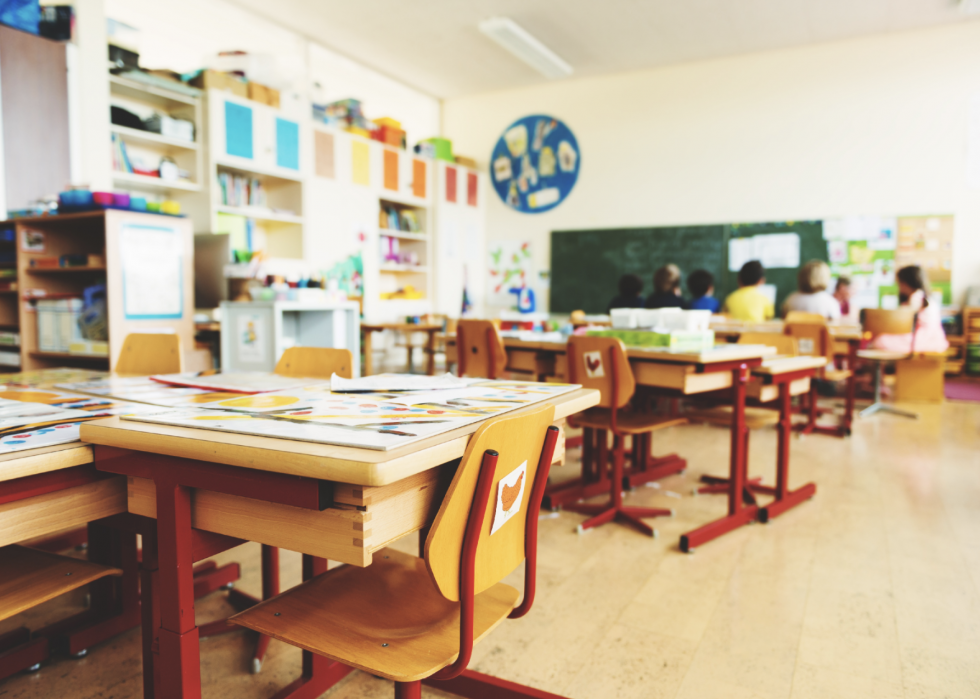
#5. Vermont
- Total spending per pupil: $19,340 (53.3% more than national average)
- Salaries and wage spending: $10,695 (48.1% more than national average)
- Employee benefits spending: $4,828 (53.2% more than national average)
- Pupil support spending: $1,745 (131.4% more than national average)
- Instructional staff support spending: $913 (51.7% more than national average)
- General administrative spending: $408 (72.2% more than national average)
Funding for Vermont schools comes two-thirds from property taxes and the balance from consumption taxes like sales and vehicle levies. With businesses closed and spending off due to the coronavirus, officials have predicted the state would see consumption tax revenues drop by $89 million in 2020, leaving an operating budget of $40 million.
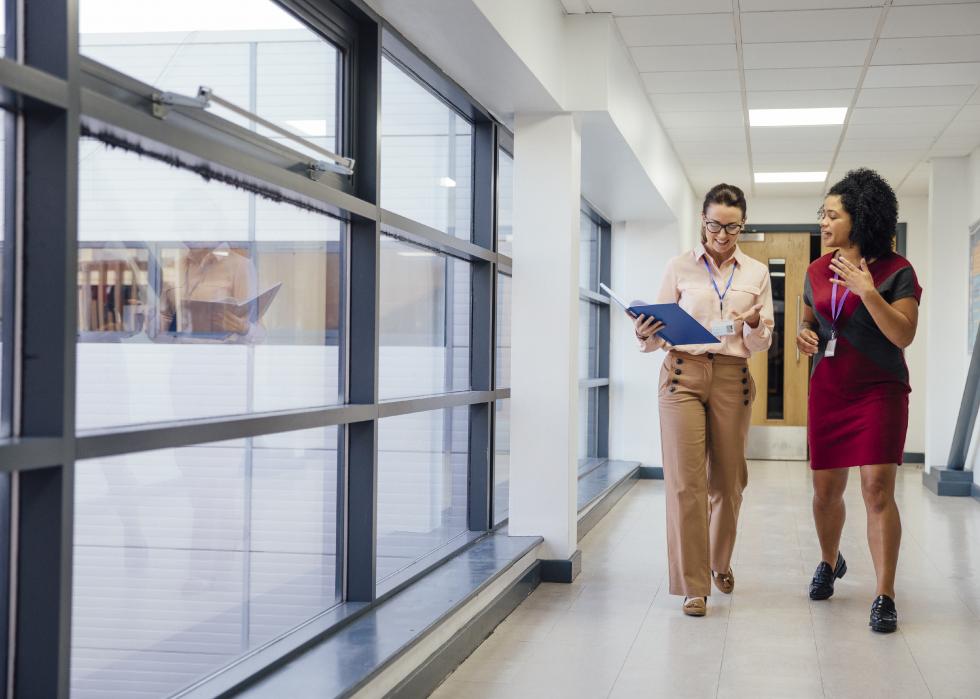
#4. New Jersey
- Total spending per pupil: $20,021 (58.7% more than national average)
- Salaries and wage spending: $11,049 (53% more than national average)
- Employee benefits spending: $5,664 (79.8% more than national average)
- Pupil support spending: $2,221 (194.6% more than national average)
- Instructional staff support spending: $782 (29.9% more than national average)
- General administrative spending: $382 (61.2% more than national average)
Facing an economic downturn due to the coronavirus, New Jersey kept school funding flat from the previous year in its latest budget. The state’s existing funding system was set up in 2008 after several court rulings found the previous system discriminated against poor urban districts. New research showed New Jersey school funding as a percentage of personal income peaked in 2009 at 4.25% and dropped to 2.71% by 2017, with the greatest cuts in districts with large populations of students of color.
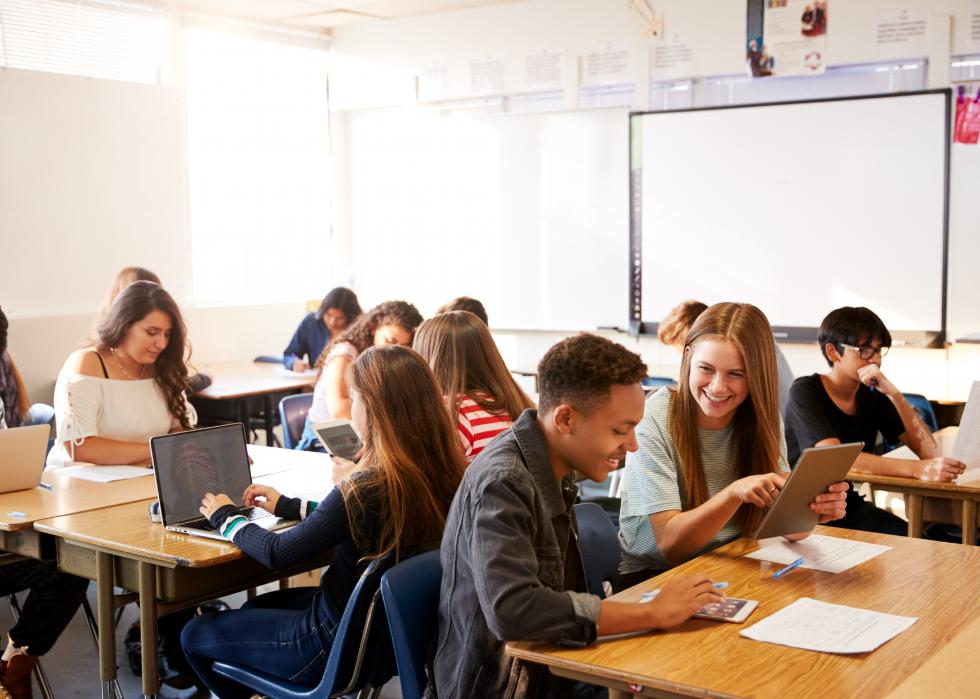
#3. Connecticut
- Total spending per pupil: $20,635 (63.6% more than national average)
- Salaries and wage spending: $11,127 (54% more than national average)
- Employee benefits spending: $6,007 (90.6% more than national average)
- Pupil support spending: $1,495 (98.3% more than national average)
- Instructional staff support spending: $732 (21.6% more than national average)
- General administrative spending: $523 (120.7% more than national average)
A number of recent research reports said Connecticut needed to spend from $338 million to $1.7 billion more a year to bridge the gap between its poor and rich school districts. More than half the state’s students are enrolled in districts with inadequate spending, the research said. In Hartford, where students are predominantly low-income and Black and Hispanic, spending would have to increase by 47% to match the statewide average.
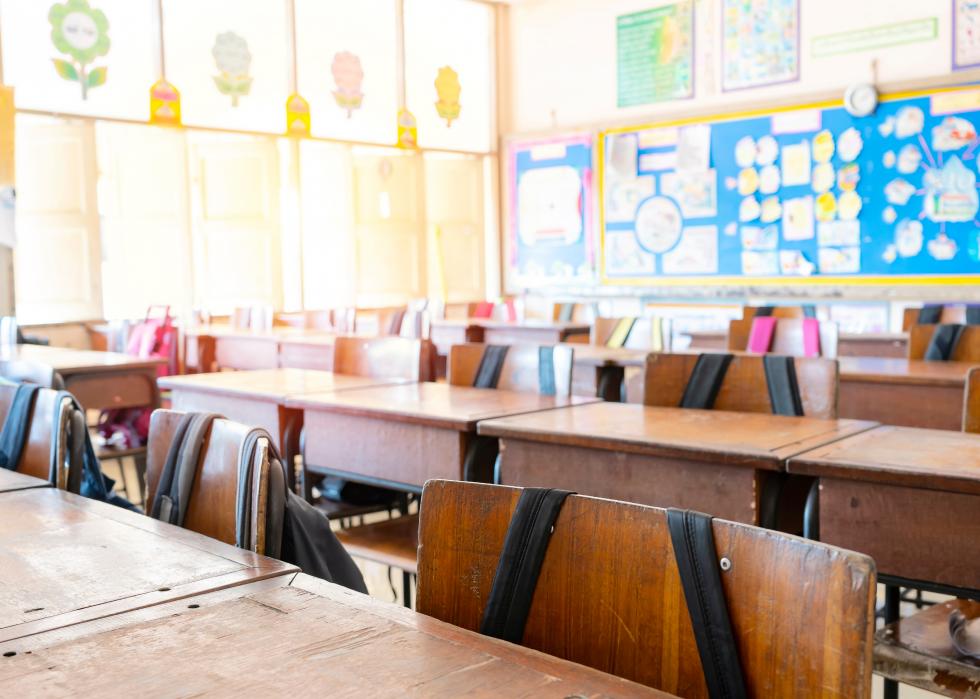
#2. Washington DC
- Total spending per pupil: $22,759 (80.5% more than national average)
- Salaries and wage spending: $15,020 (107.9% more than national average)
- Employee benefits spending: $3,055 (3% less than national average)
- Pupil support spending: $740 (1.9% less than national average)
- Instructional staff support spending: $946 (57.1% more than national average)
- General administrative spending: $1,908 (705.1% more than national average)
The D.C. Council approved a budget in the summer of 2020 that kept a 3% increase in per-student funding. It allocated $3.2 million for school-based mental health resources and also $900,000 for literacy intervention to ensure that students are reading at grade level by third grade.

#1. New York
- Total spending per pupil: $24,040 (90.6% more than national average)
- Salaries and wage spending: $12,745 (76.5% more than national average)
- Employee benefits spending: $6,813 (116.2% more than national average)
- Pupil support spending: $721 (4.4% less than national average)
- Instructional staff support spending: $638 (6% more than national average)
- General administrative spending: $363 (53.2% more than national average)
New York state withheld school funding over the spring and summer due to coronavirus-linked revenue shortfalls. The state government held back 20% of payments to school districts, as well as municipalities and social service providers, prompting some districts to lay off staff. The New York State United Teachers union sued, claiming the withholding was unconstitutional.



